Austenite Grain Growth Analysis in a Welded Joint of High-Strength Martensitic Abrasion-Resistant Steel Hardox 450
Abstract
1. Introduction
- σy is the yield point;
- σ0 is the friction resistance for dislocation movement within the polycrystalline grain;
- ky is consolidation coefficient—a measure of the local stress needed at a grain boundary for the transmission of plastic flow—unpinning constant;
- d is an average grain size
- G is the shear modulus;
- τb is the Burgers vector (dependent on the type of crystal lattice);
- q is the geometric factor (dependent on lattice type);
- b is the critical stress required to transmit sliding through grains boundary
- σf is the material strength;
- σ0f and kf are experimentally determined constants, for kf > ky
- γ is the fracture surface energy;
- ν is the Poisson’s ratio.
2. Material and Research Methodology
- Weld type: BW (butt weld);
- Welding position: PA (flat position);
- Electrode diameter: 3.0 mm;
- Arc voltage (weld 1/2): 31/33 V;
- Current (weld No. 1): 530 A;
- Current (weld No. 2): 630 A;
- Polarity: DC (+);
- Welding speed: ~10 mm/s;
- Electrode wire: OK Autrod 13.43 (S3Ni2.5CrMo according to EN ISO 26304);
- Flux: OK Flux 10.62 (MgO, CaF2, Al2O3, SiO2);
- Preheating: none;
- Interpass temperature: ≤80 °C;
- Preparation of plate edges for welding (bevelling): none.
3. Results
3.1. Hardness Masurements and Microstructure Observations
3.2. Strength and Impact Tests
3.3. Analysis of Grain Size Changes in Prior Austenite
- The structural transformations occurring during welding caused a radical reduction in the impact strength parameters of the tested joint. This conclusion applies primarily to the reduced test temperatures. Compared to the ambient temperature, in which the impact strength of the welded joint did not raise any doubts (KCV+20 = 130 J/cm2) (bar D in Figure 21a), lowering the temperature barrier to −40 °C caused in the discussed case the occurrence of the brittleness point, which was manifested by the impact strength level KCV−40 = 17 J/cm2 (bar D in Figure 21b).
- Despite very low impact strength indices at reduced temperatures and unsatisfactory strength properties, the welded joint of Hardox 450 in the delivery state was characterised by relatively high indices determining plastic properties, i.e., percentage elongation after fracture A = 22.9% and reduction of area Z = 50.4% (bars D in Figure 20b).
- The thermal treatment of the welded joint of Hardox 450 steel, consisting of normalising at 900 °C and hardening from temperatures in the range of 900–1200 °C, resulted in a significant increase in the strength (Rm) and ductility (A and Z) indices of the tested material, with only slight differences between them being a function of the increased austenitising temperature (Figure 20). The annealing of the welded joint before hardening in the range 900–1200 °C allowed obtaining the mechanical parameters within the following ranges (respectively to temperature): Rm = 1293–1224 MPa (Figure 20a), A = 22.9–18.5% and Z = 56.8–50.4% (Figure 20b).
- The conducted investigations showed that for the impact test carried out at +20 °C, austenitising in the temperature range 900–1200 °C allowed obtaining the impact strength in the range of KCV+20 = 110–51 J/cm2, respectively. The influence of an increased austenitisation temperature on the impact toughness characteristics of the considered welded joint was also recorded at a reduced test temperature. In the above-described range of annealing temperatures before hardening, the obtained range of impact strength ranged from KCV−40 = 38–15 J/cm2, respectively. In this case, the brittleness point is definitely noticeable already at the austenitising temperature of 1000 °C.
- The considerations presented above, mainly concerning the impact properties of the welded joint of Hardox 450 steel, are reflected in the results of the analysis of the prior austenite grain size (Figure 64 and Figure 65). It can be stated that in the delivery state, the parent material is characterised by an average prior austenite grain size of 15.7 μm. The quenching procedures carried out from temperatures in the range of 900–1000 °C did not induce in this case any significant changes in the grain size, which can be approximated to 22 μm. It is only the quenching from higher temperatures, i.e., 1100 °C and 1200 °C, that causes a sharp increase in the average grain size, to 28.2 μm and 41.9 μm, respectively. The weld material, designated WM1 and WM2, is characterised by the finest and at the same time irregular grain size of the prior austenite. Grains smaller than 10 μm are the most numerous, with an average size of 9.7 μm (WM1) and 9.3 μm (WM2). An increase in average grain size from 11.1 to 34.6 μm for WM1 and from 8.3 to 33.1 μm for WM2 is observed in the weld material as a result of quenching processes from temperatures ranging from 900 to 1200 °C. However, it should be noted that the values obtained are slightly smaller than the corresponding values in the parent material. The fusion line between the individual weld layers (marked as WM3) is characterised by irregular grain growth, which is the result of a limited possibility of recrystallisation. The values obtained are either smaller than those obtained in the adjacent zones WM1 and WM2, or they are close to them. The most critical, from the point of view of impact properties, zone of the fusion line, marked as FL in Figure 2, is characterised by significant variation of grain size with the average value close to the one in the weld metal (WM1 and WM2). This situation is observed in this zone in all analysed cases of austenitising temperatures. On the other hand, as regards the heat-affected zone, the average grain size, both in the delivery state and in the quenched state from the temperatures ranging from 900 to 1200 °C, corresponds to analogous values in the parent material, which proves that there is no tendency for grain growth in this area as a result of increased temperature.
Author Contributions
Funding
Institutional Review Board Statement
Informed Consent Statement
Data Availability Statement
Conflicts of Interest
References
- SSAB, SSAB High-Strength Steel—Sheet, Plate, Coil, Tube, Profile. 2021. Available online: https://www.ssab.com/products/brands/hardox (accessed on 16 February 2021).
- Stal-Hurt, Stal-Hurt Data sheet Hardox, (n.d.). Available online: https://www.stal-hurt.com/ (accessed on 30 December 2020).
- Białobrzeska, B.; Konat, Ł. Comparative analysis of abrasive-wear resistance of Brinar and Hardox steels. Tribologia 2017, 272, 7–16. [Google Scholar] [CrossRef]
- Białobrzeska, B.; Konat, Ł.; Jasiński, R. The Influence of Austenite Grain Size on the Mechanical Properties of Low-Alloy Steel with Boron. Metals 2017, 7, 26. [Google Scholar] [CrossRef]
- Cegiel, L.; Konat, Ł.; Pawłowski, T.; Pękalski, G. Hardox Steels—New generations of construction materials for surface mining machinery. Brown Coal 2006, 3, 24–29. [Google Scholar]
- Dudziński, W.; Białobrzeska, B.; Konat, Ł. Comparative analysis of structural and mechanical properties of selected low-alloy boron-containing abrasive-wear resistant steels. In Polish Metall. Years 2011–2014; Świątkowski, K., Dańko, J., Dutkiewicz, J., Kuziak, R., Kazior, J., Eds.; Publishing House “AKAPIT”: Cracow, Poland, 2014; pp. 871–888. [Google Scholar]
- Dudziński, W.; Konat, Ł.; Pękalska, L.; Pękalski, G. Structures and properties of Hardox 400 and Hardox 500 steels. Mater. Eng. 2006, 27, 139–142. [Google Scholar]
- Dudziński, W.; Konat, Ł.; Pękalski, G. Structural and strength characteristics of wear-resistant martensitic steels. Arch. Foundry Eng. 2008, 8, 21–26. [Google Scholar]
- Frydman, S.; Konat, Ł.; Łętkowska, B.; Pękalski, G. Impact resistance and fractography of low-alloy martensitic steels. Arch. Foundry Eng. 2008, 8, 89–94. [Google Scholar]
- Konat, Ł. Structures and Properties of Hardox Steels and Their Application Possibilities in Conditions of Abrasive Wear and Dynamic Loads. Ph.D. Thesis, Wrocław University of Science and Technology, Wrocław, Poland, 2007. [Google Scholar]
- Konat, Ł.; Pękalski, G. Assessment of the condition of the constructional. In Maintenance Strategy of Surface Mining Machines and Facilites with High Degree Technical Degradation; Dudek, D., Ed.; Publishing House of Wrocław University of Science and Technology: Wroclaw, Poland, 2013; pp. 329–340. [Google Scholar]
- Pawlak, K.; Białobrzeska, B.; Konat, Ł. The influence of austenitizing temperature on prior austenite grain size and resistance to abrasion wear of selected low-alloy boron steel. Arch. Civ. Mech. Eng. 2016, 16, 913–926. [Google Scholar] [CrossRef]
- Frydman, S.; Konat, Ł.; Pękalski, G. Structure and hardness changes in welded joints of Hardox steels. Arch. Civ. Mech. Eng. 2008, 8, 15–27. [Google Scholar] [CrossRef]
- Morito, S.; Tanaka, H.; Konishi, R.; Furuhara, T.; Maki, A.T. The morphology and crystallography of lath martensite in Fe-C alloys. Acta Mater. 2003, 51, 1789–1799. [Google Scholar] [CrossRef]
- Wang, C.; Wang, M.; Shi, J.; Hui, W.; Dong, H. Effect of microstructure refinement on the strength and toughness of low alloy martensitic steel. J. Mater. Sci. Technol. 2007, 23, 659–664. [Google Scholar]
- Prawoto, Y.; Jasmawati, N.; Sumeru, K. Effect of Prior Austenite Grain Size on the Morphology and Mechanical Properties of Martensite in Medium Carbon Steel. J. Mater. Sci. Technol. 2012, 28, 461–466. [Google Scholar] [CrossRef]
- Morris, J.W. The Influence of Grain Size on the Mechanical Properties of Steel; U.S. Department of Energy, Office of Scientific and Technical Information: Berkeley, CA, USA, 2001. [Google Scholar] [CrossRef]
- Maciejny, A. Brittleness of Metals; Publishing House “Śląsk”: Katowice, Poland, 1973. [Google Scholar]
- Wang, C.; Wang, M.; Shi, J.; Hui, W.; Dong, H. Effect of microstructural refinement on the toughness of low carbon martensitic steel. Scr. Mater. 2008, 58, 492–495. [Google Scholar] [CrossRef]
- Zhang, C.; Wang, Q.; Ren, J.; Li, R.; Wang, M.; Zhang, F.; Sun, K. Effect of martensitic morphology on mechanical properties of an as-quenched and tempered 25CrMo48V steel. Mater. Sci. Eng. A. 2012, 534, 339–346. [Google Scholar] [CrossRef]
- Hidalgo, J.; Santofimia, M.J. Effect of Prior Austenite Grain Size Refinement by Thermal Cycling on the Microstructural Features of As-Quenched Lath Martensite. Metall. Mater. Trans. A 2016, 47, 5288–5301. [Google Scholar] [CrossRef]
- Maki, T. Morphology and substructure of martensite in steels. In Phase Transform. Steels; Elsevier: Amsterdam, The Netherlands, 2012; pp. 34–58. [Google Scholar] [CrossRef]
- Swarr, T.; Krauss, G. The effect of structure on the deformation of as-quenched and tempered martensite in an Fe-0.2 pct C alloy. Metall. Trans. A 1976, 7, 41–48. [Google Scholar] [CrossRef]
- Haiko, O.; Javaheri, V.; Valtonen, K.; Kaijalainen, A.; Hannula, J.; Kömi, J. Effect of prior austenite grain size on the abrasive wear resistance of ultra-high strength martensitic steels. Wear 2020, 454–455, 203336. [Google Scholar] [CrossRef]
- Liu, W.; Li, J.; Shi, C.; Wang, C. Effect of Micro-alloying Element Boron on the Strengthening of High-Strength Steel Q690D. Metallogr. Microstruct. Anal. 2015, 4, 102–108. [Google Scholar] [CrossRef]
- Konat, Ł. Structural Aspects of Execution and Thermal Treatment of Welded Joints of Hardox Extreme Steel. Metals 2019, 9, 915. [Google Scholar] [CrossRef]
- ESAB. Welding Consumables; ESAB: Gothenburg, Sweden, 2012. [Google Scholar]
- Wyrzykowski, J.W.; Pleszakow, E.; Sieniawski, J. Deformation and Cracking of Metals; Publishing House “WNT”: Warsaw, Poland, 1999. [Google Scholar]
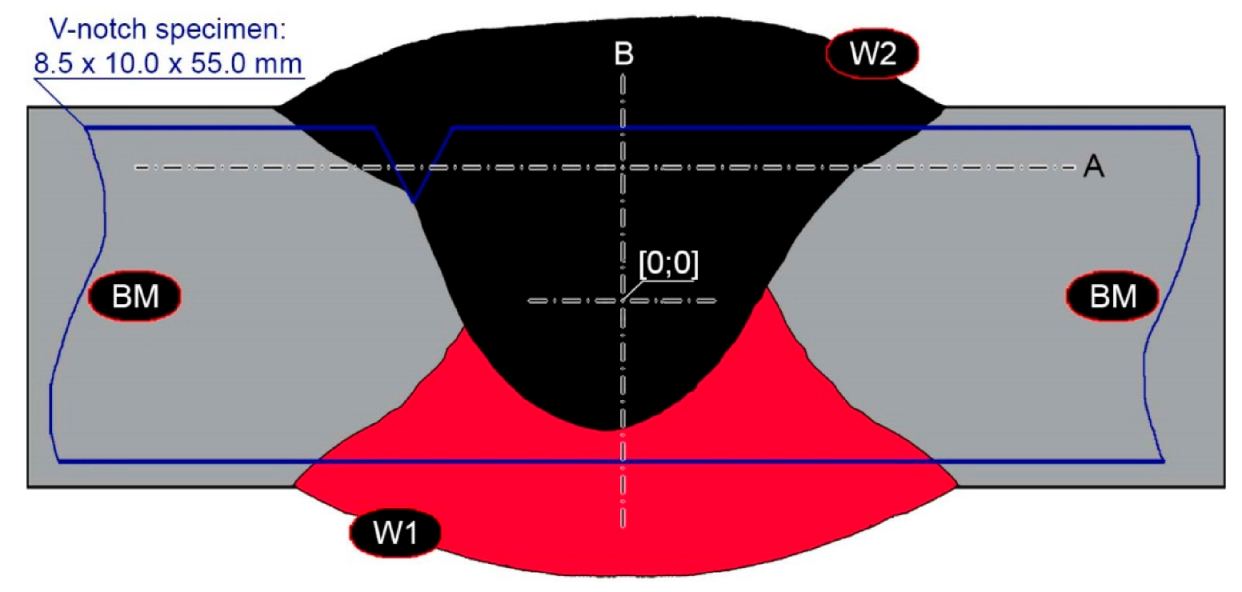



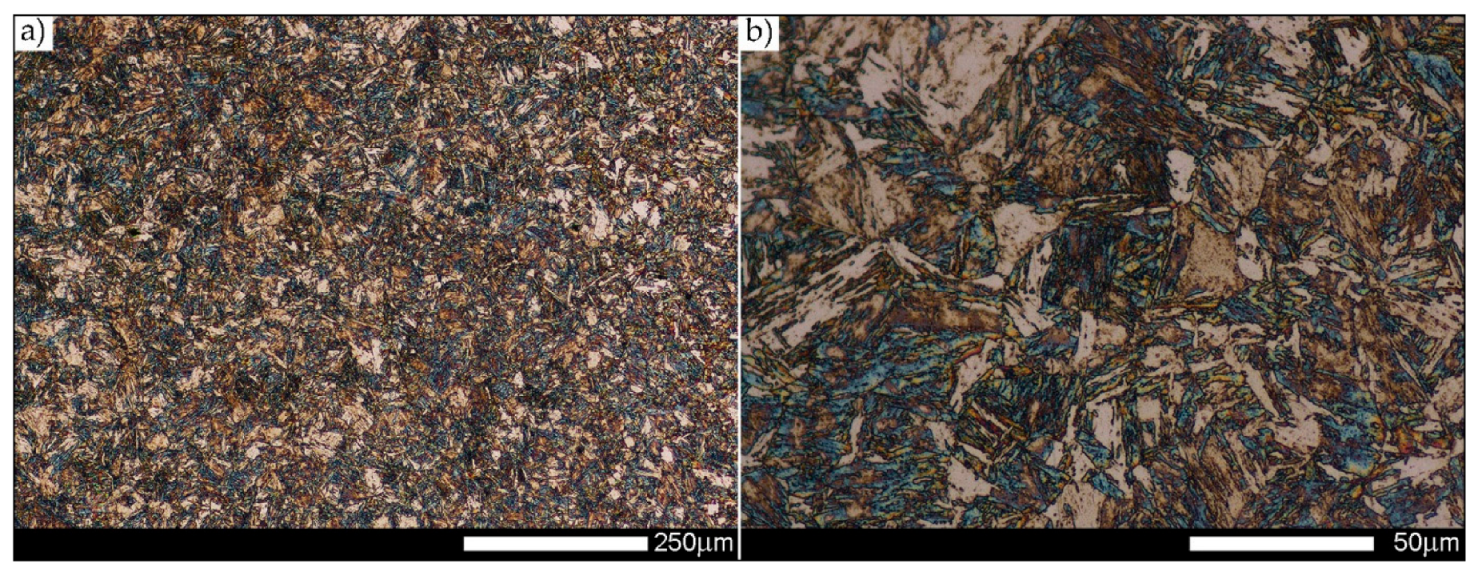
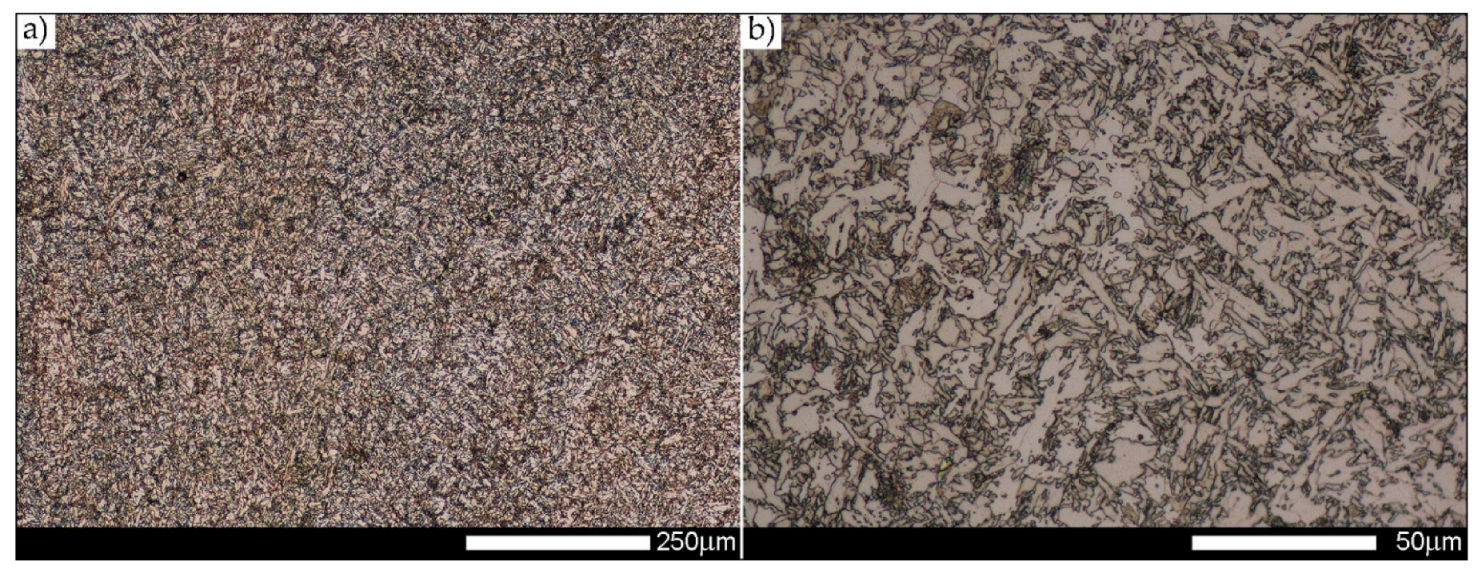
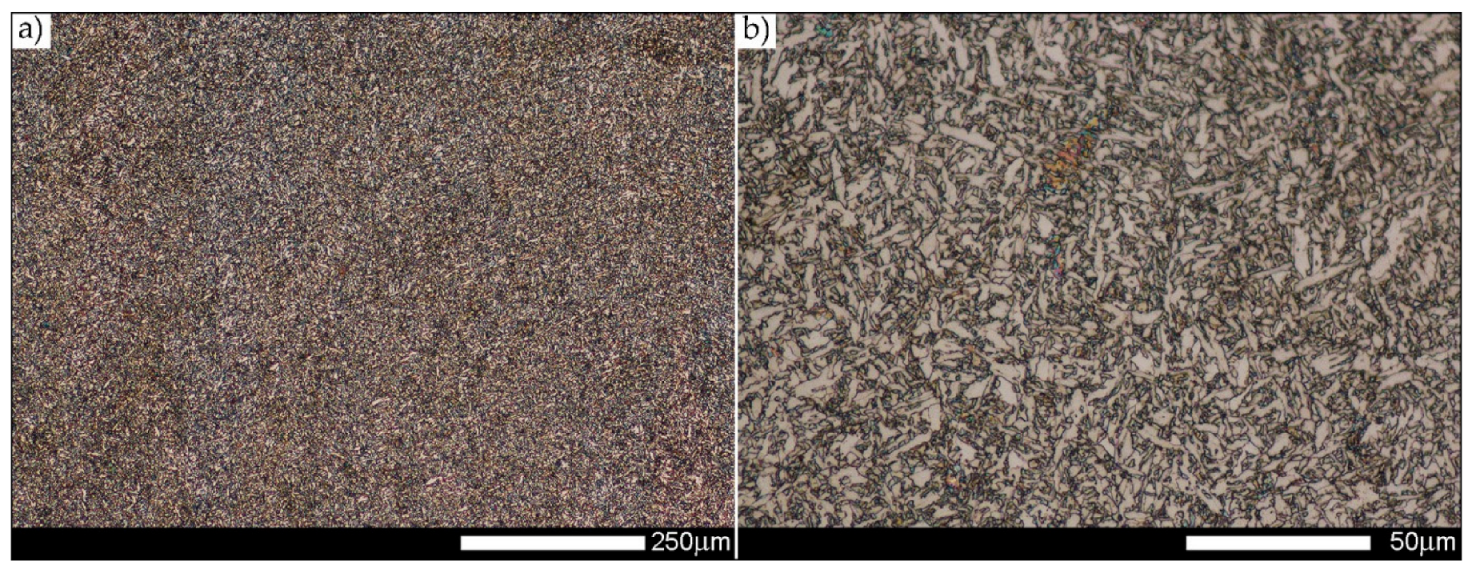
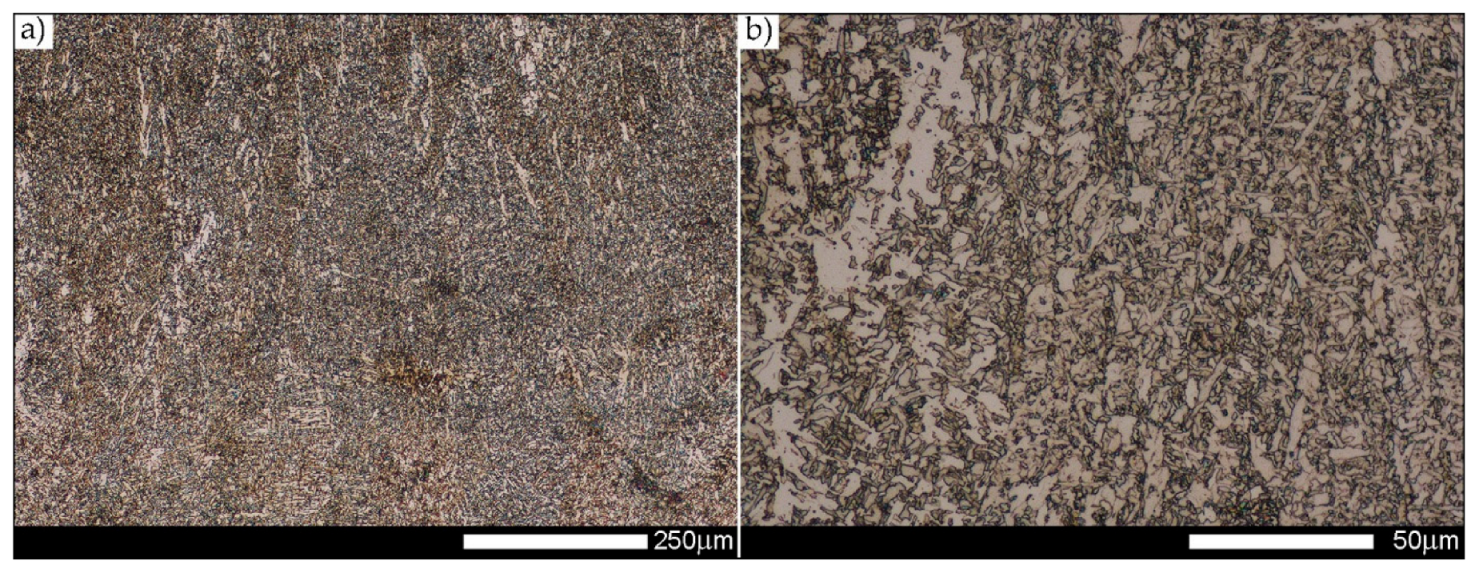
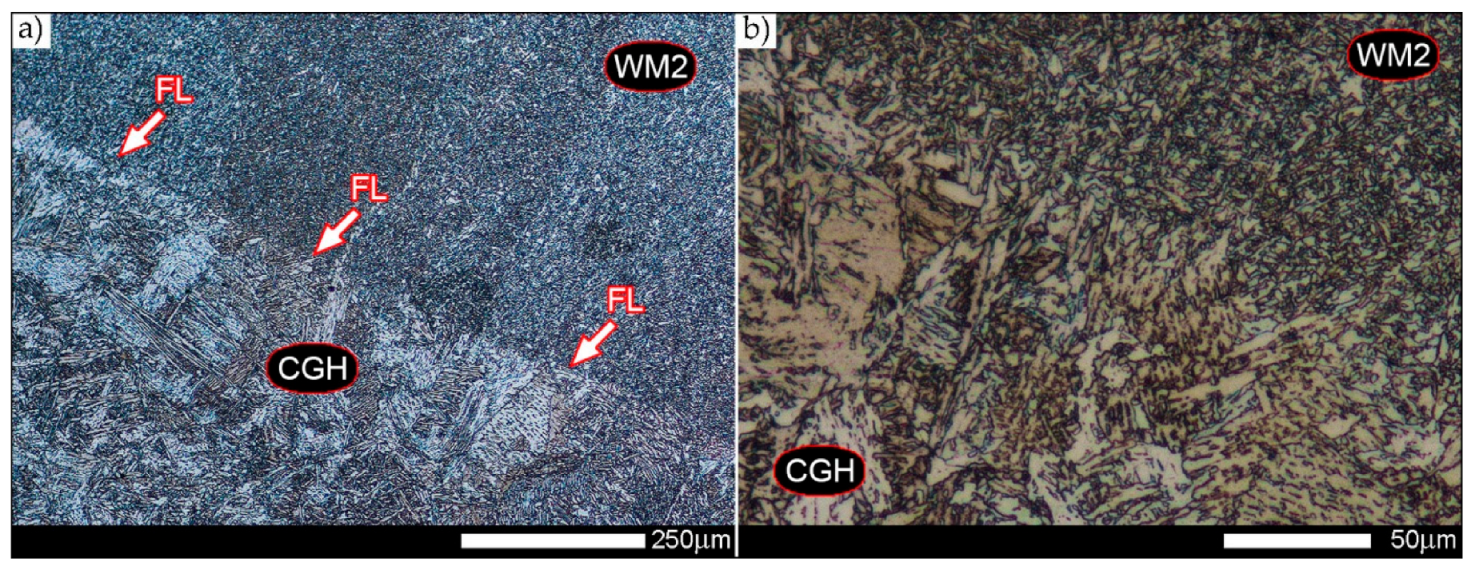
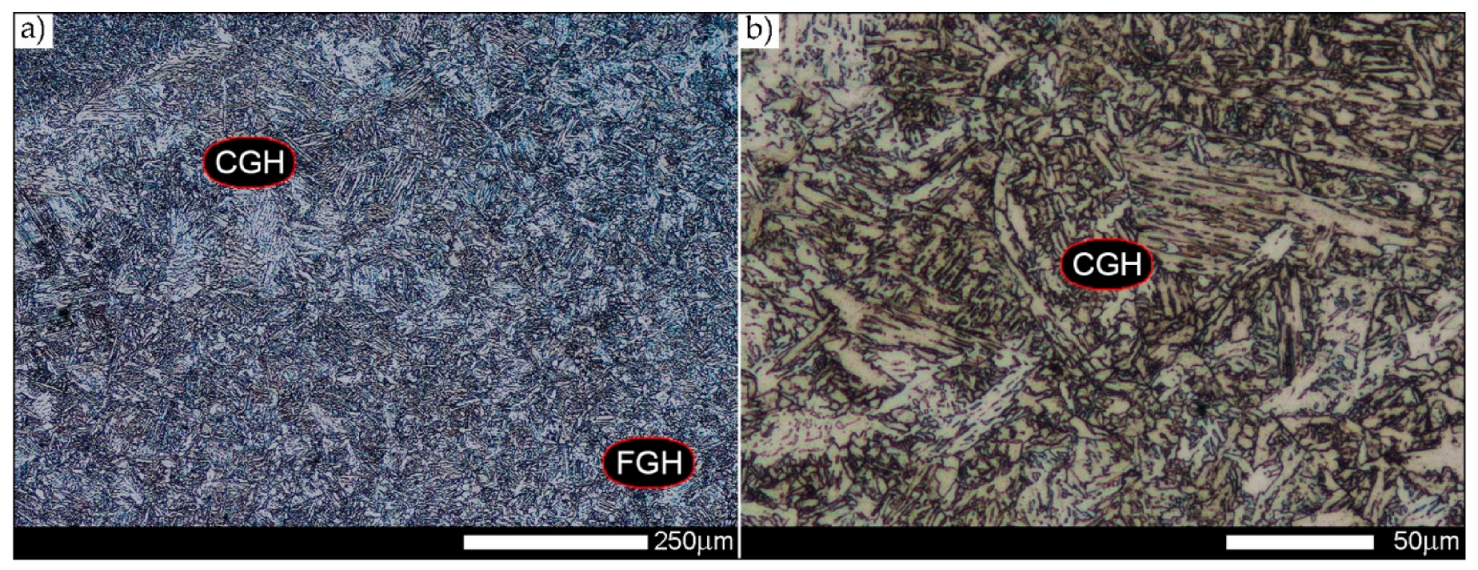

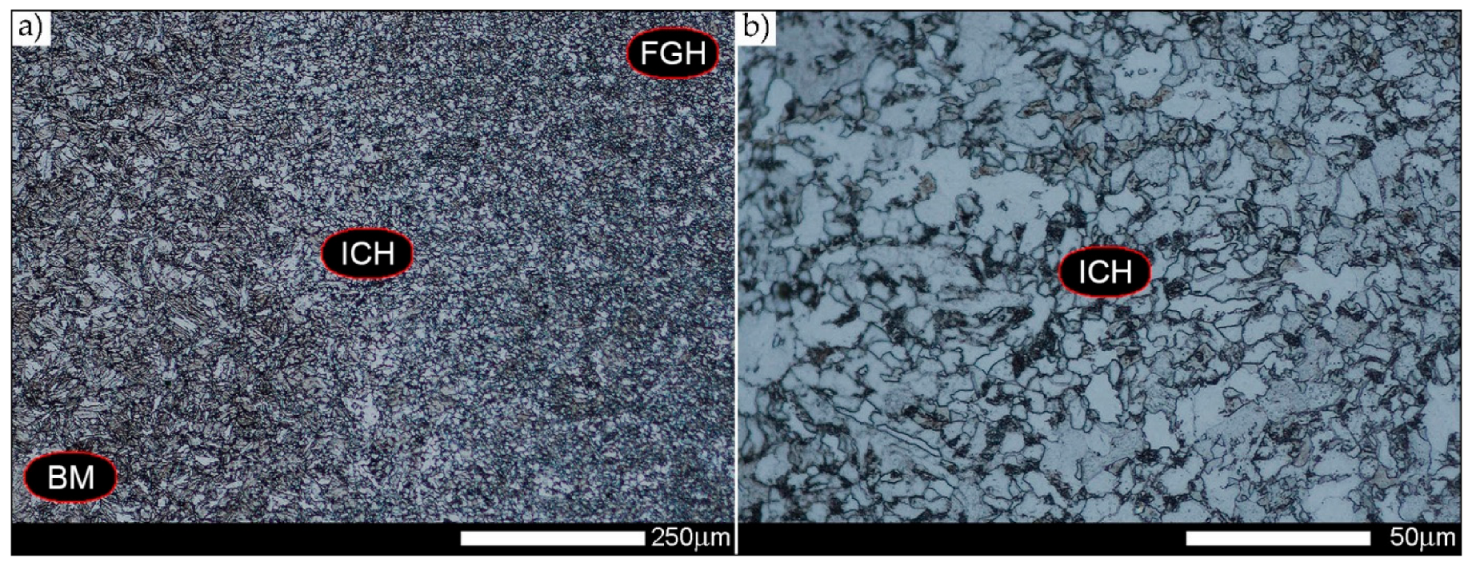

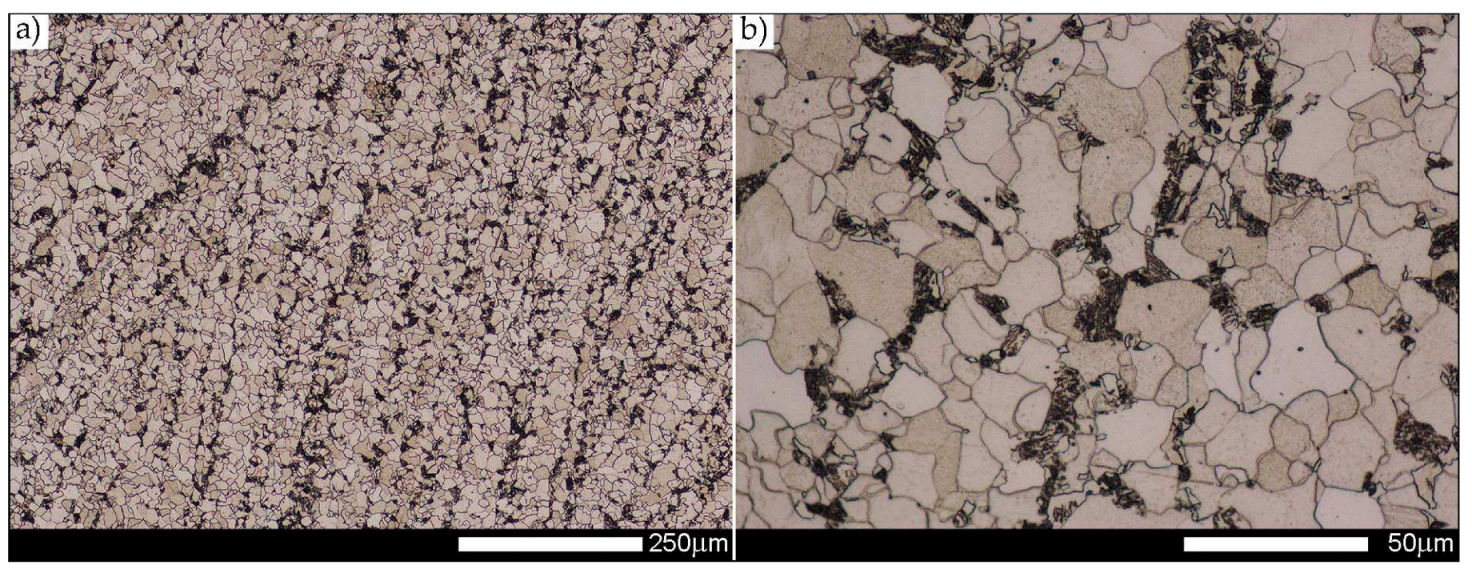
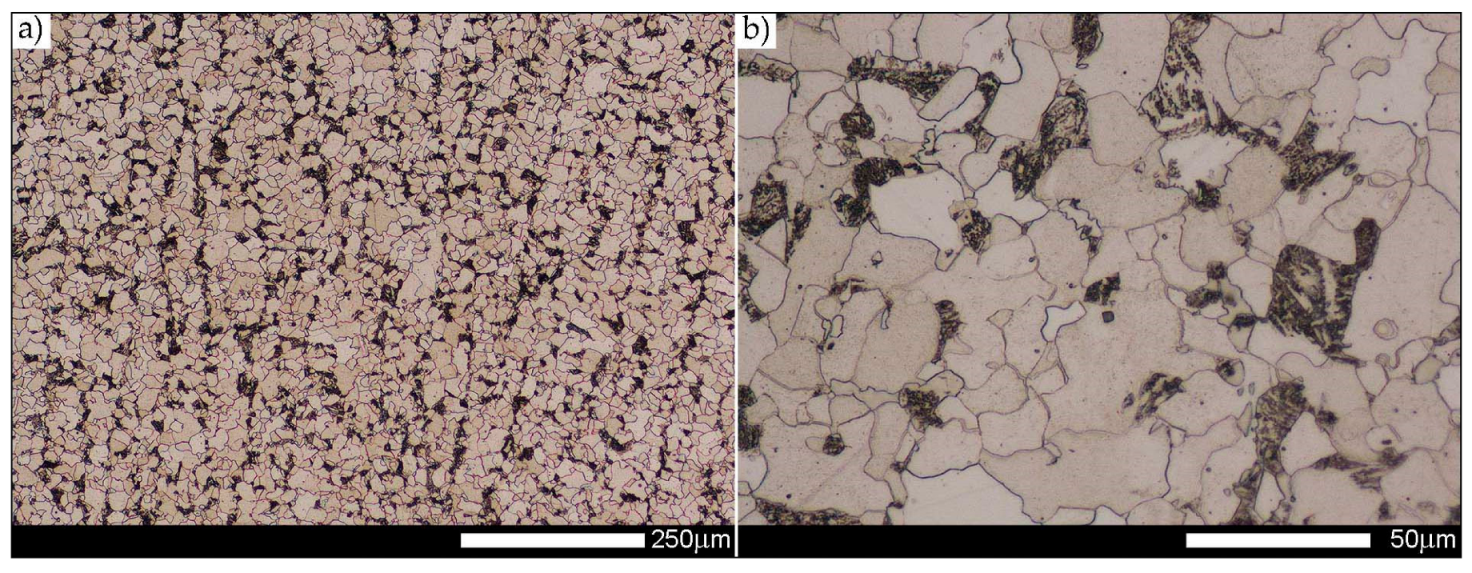

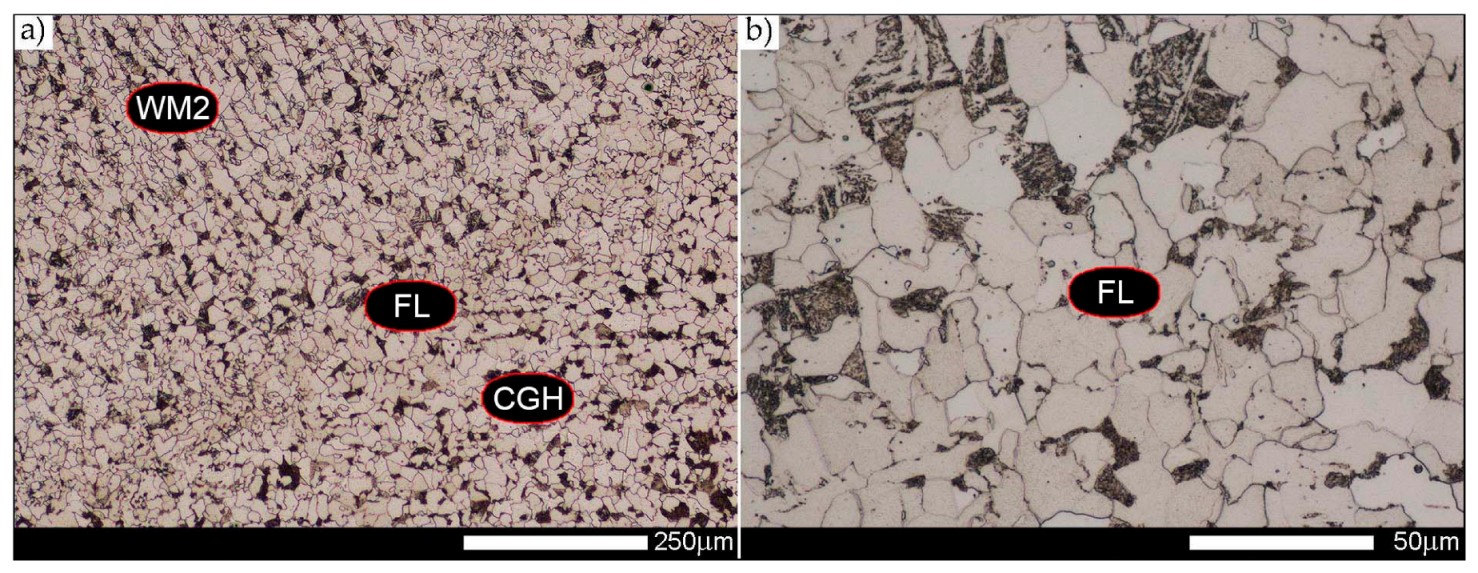
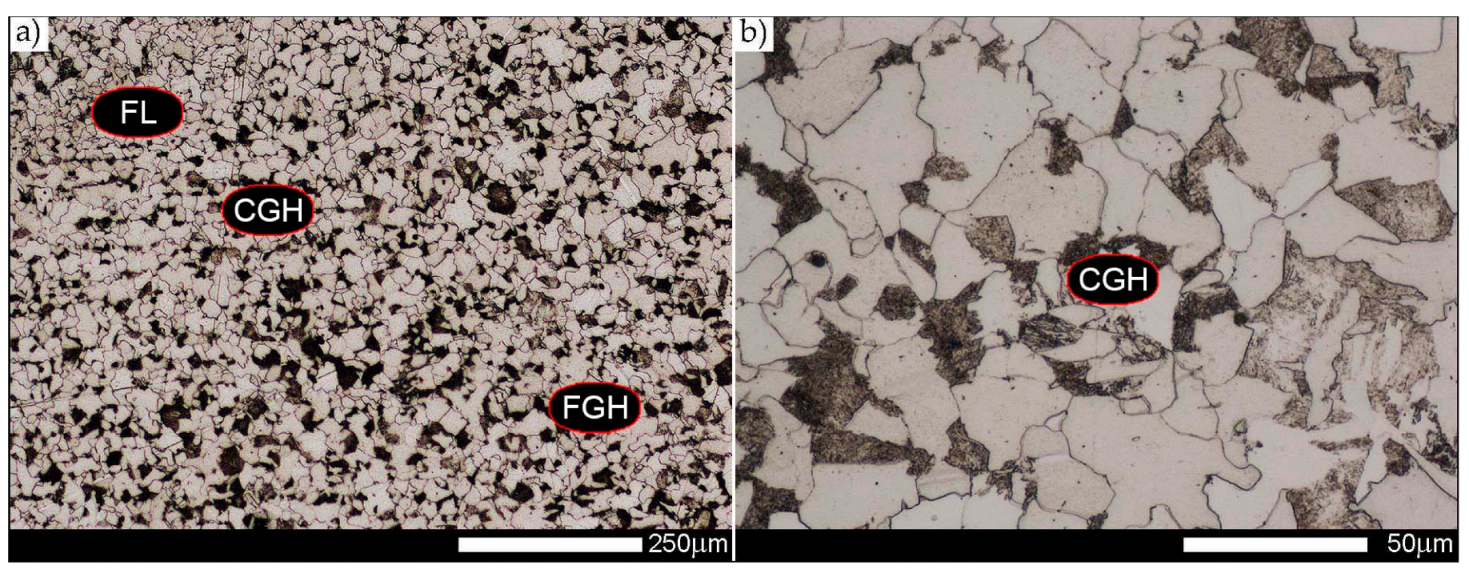
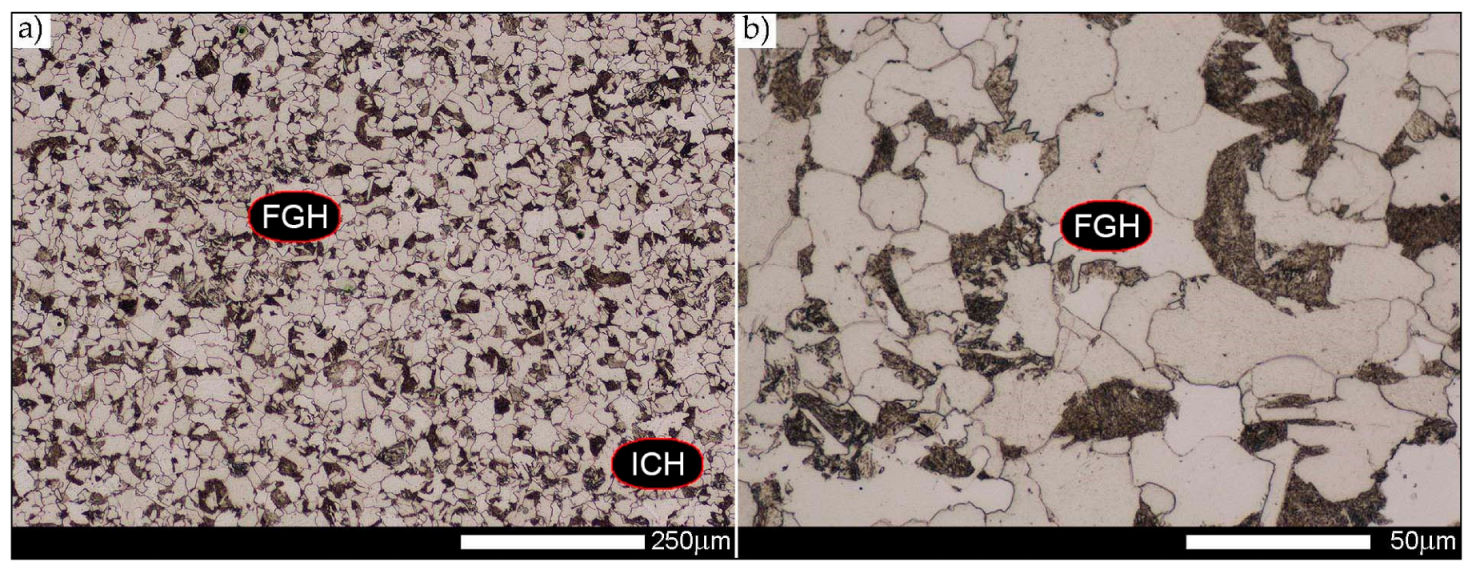


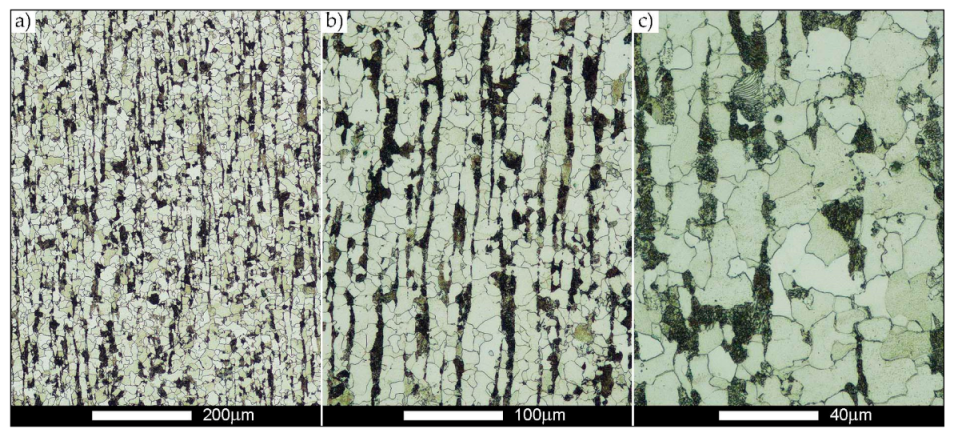

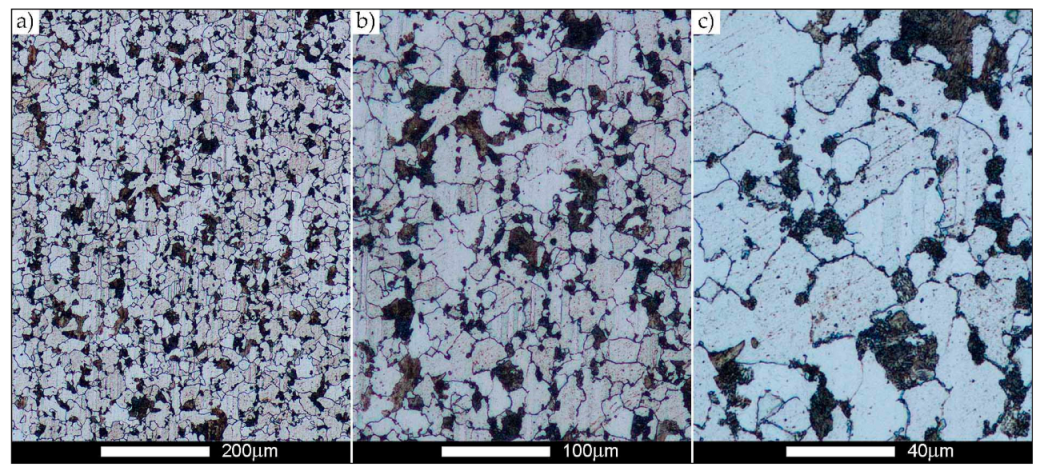
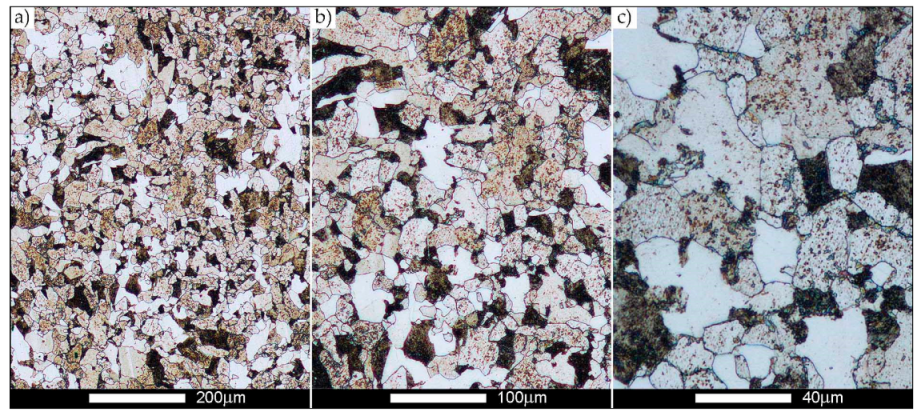
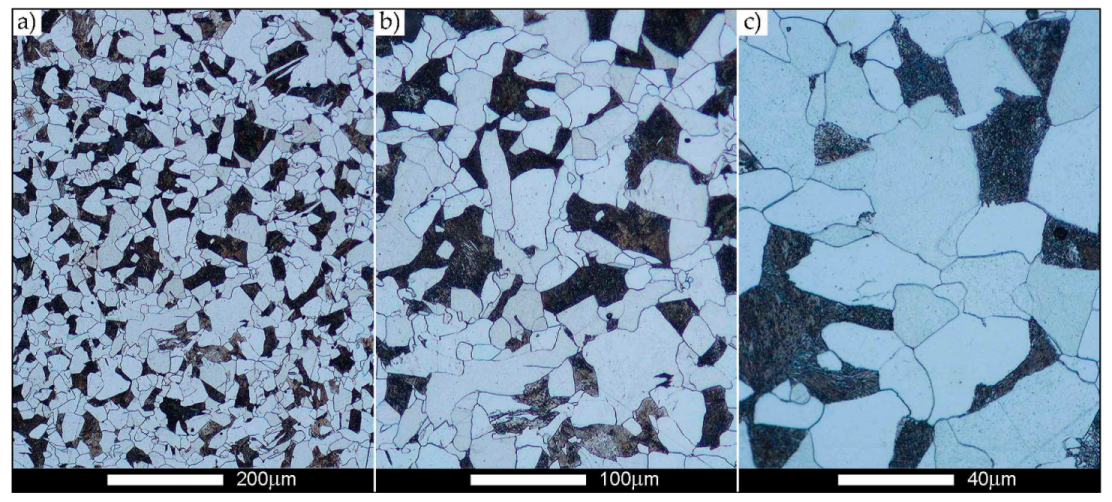
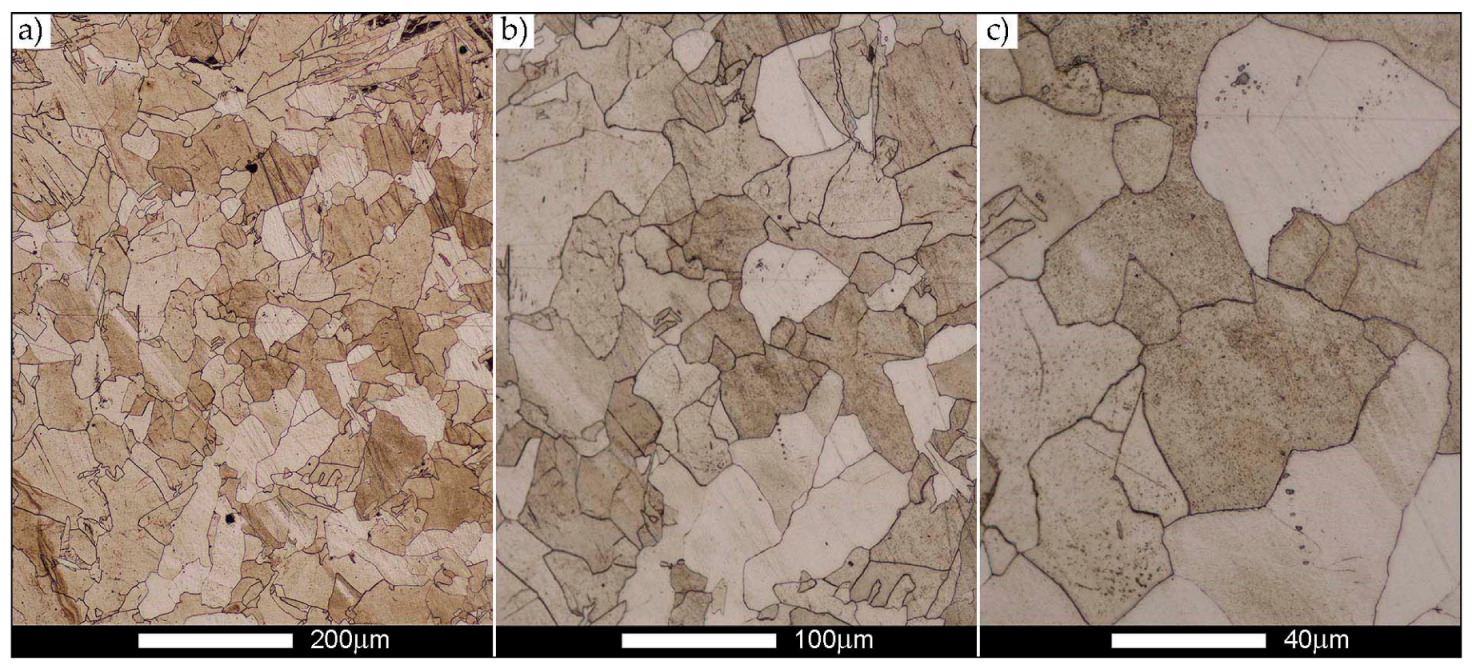
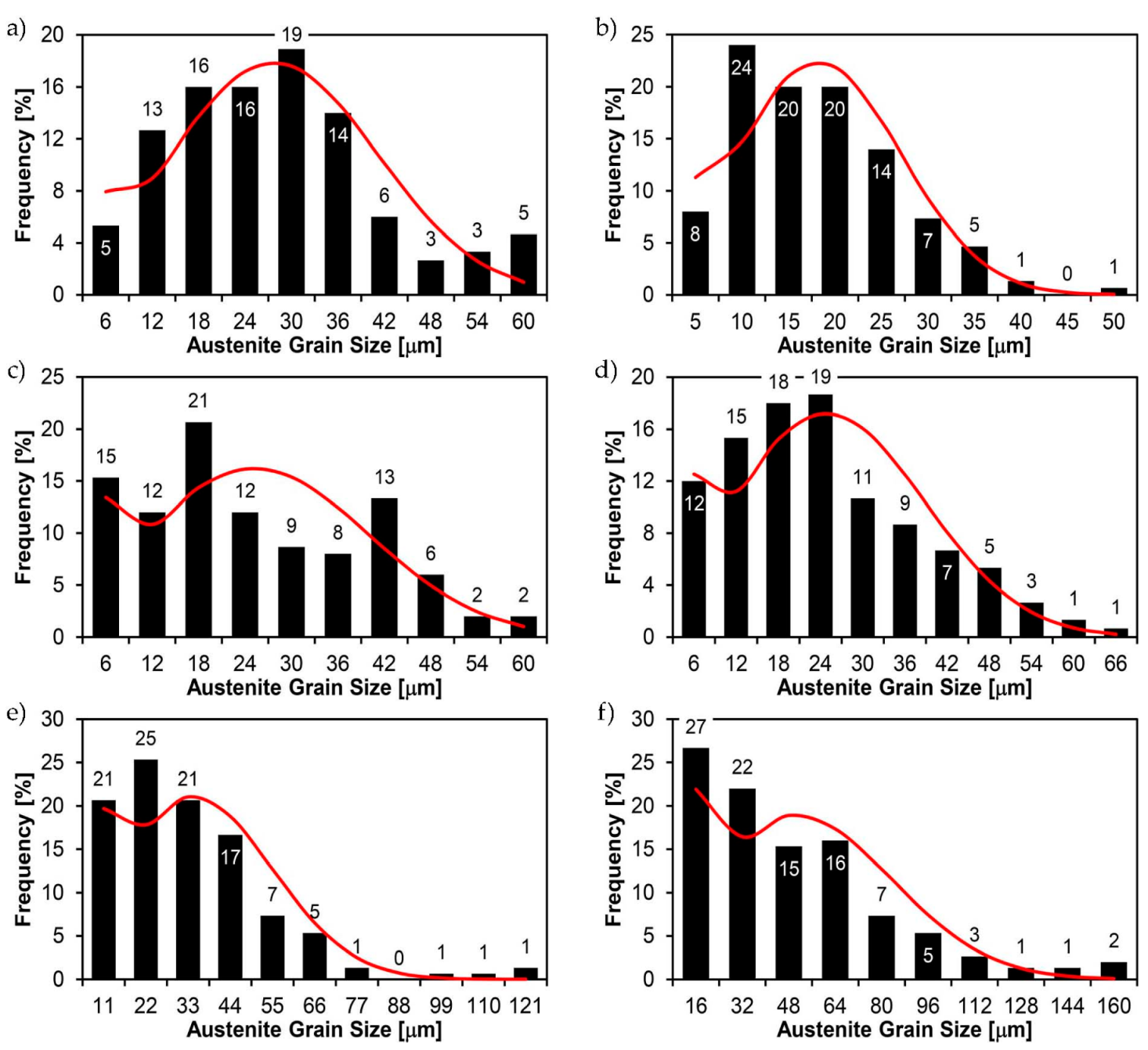

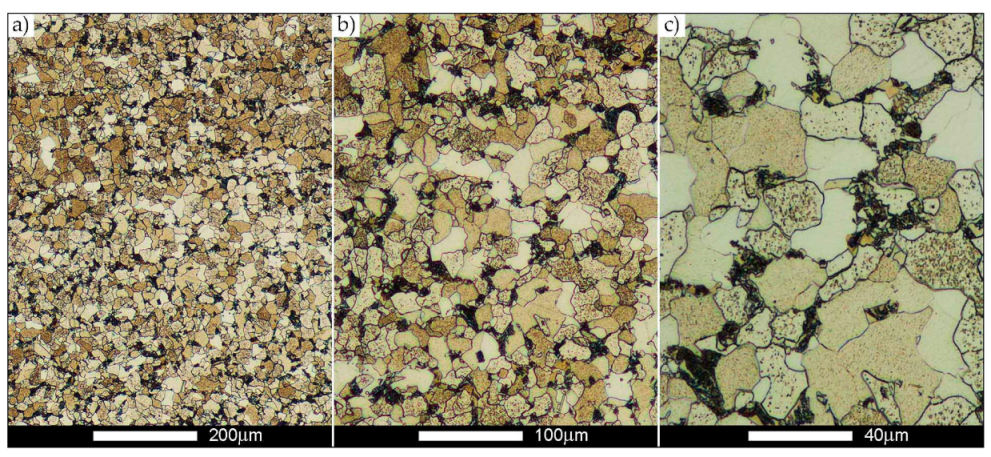
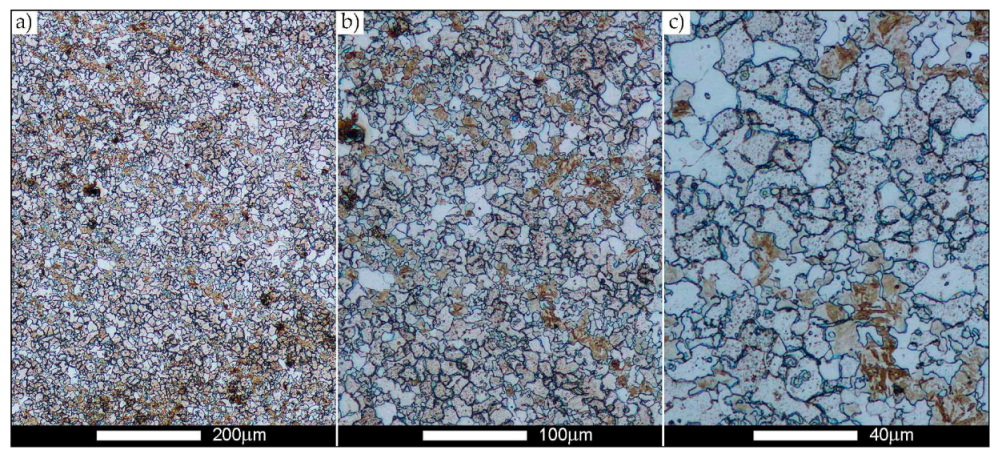

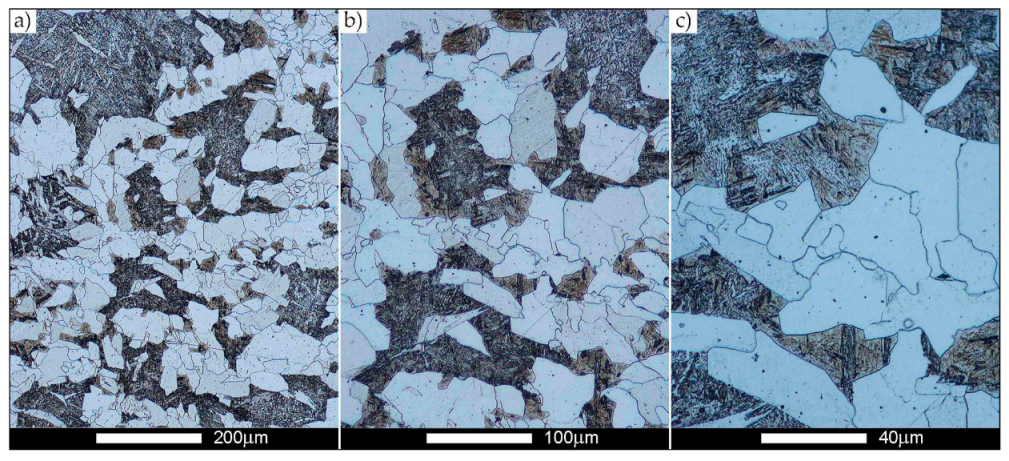


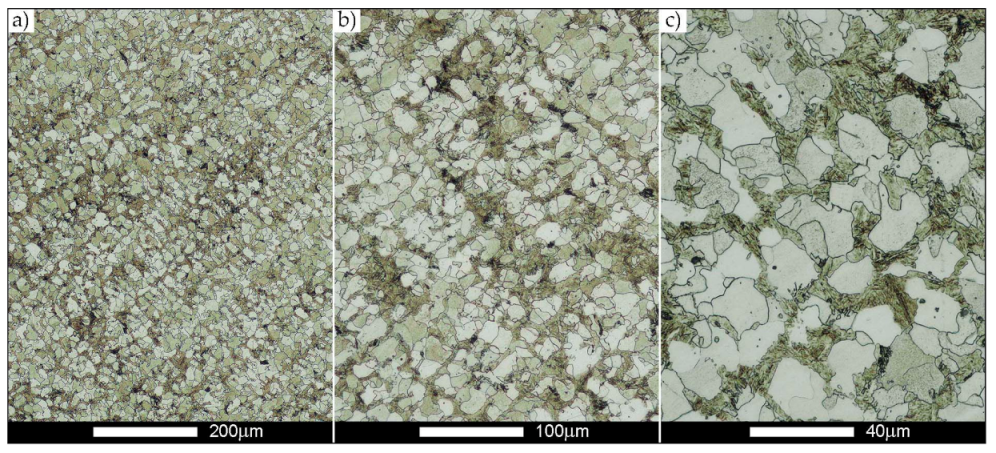
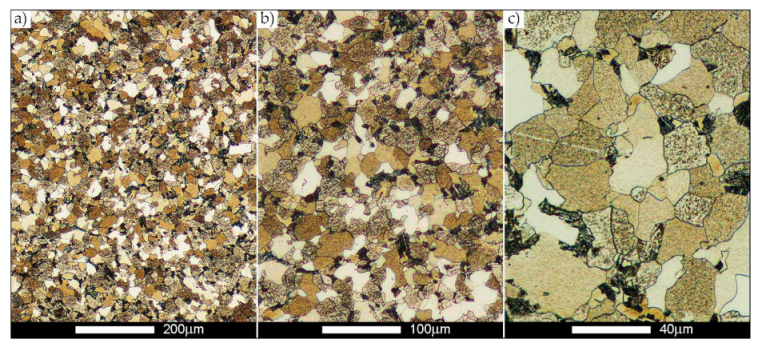
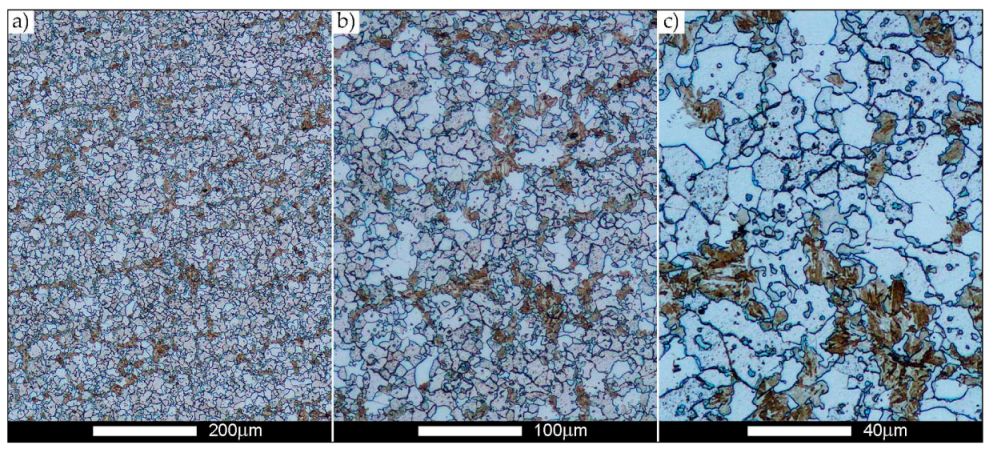
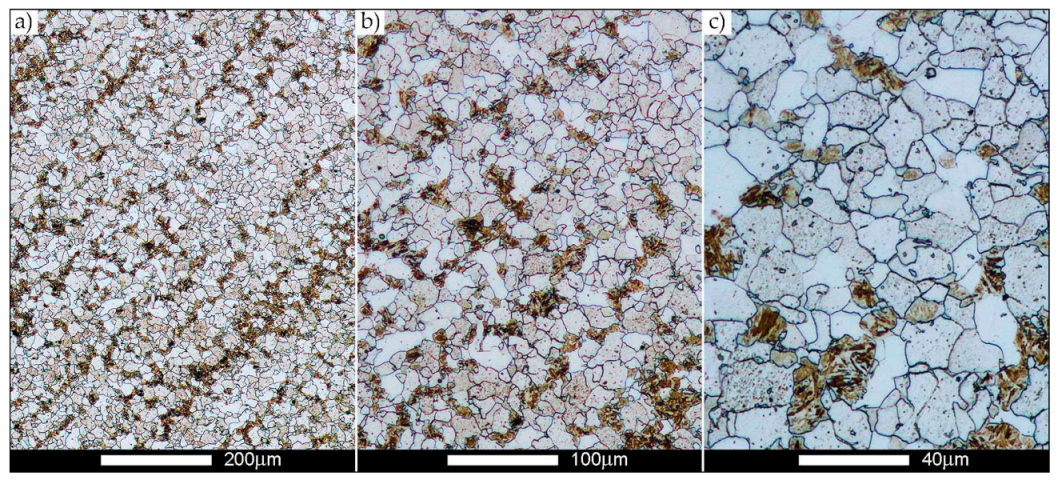
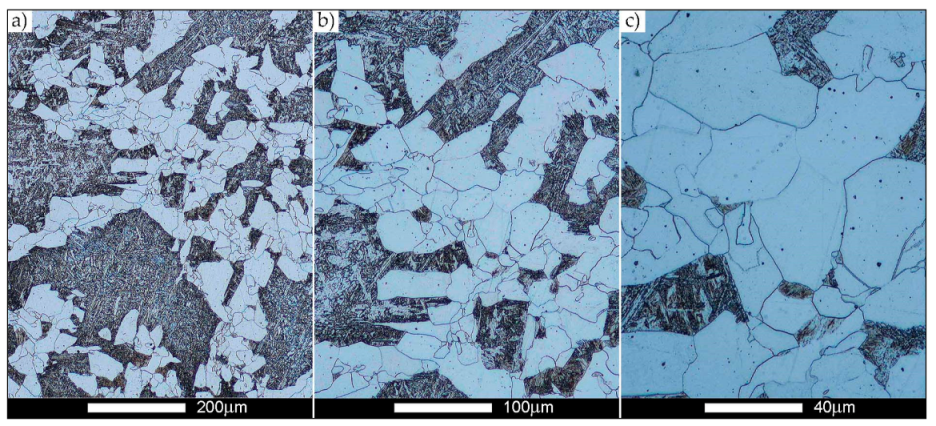
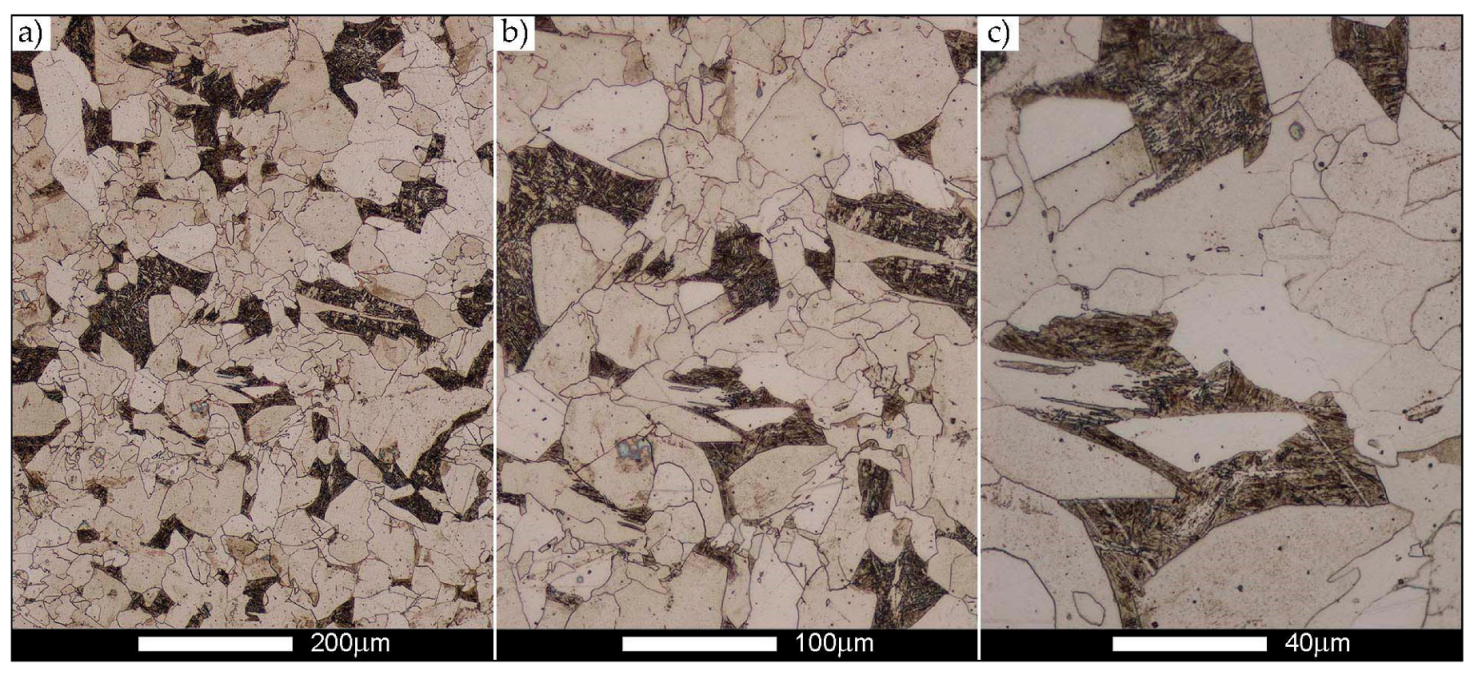
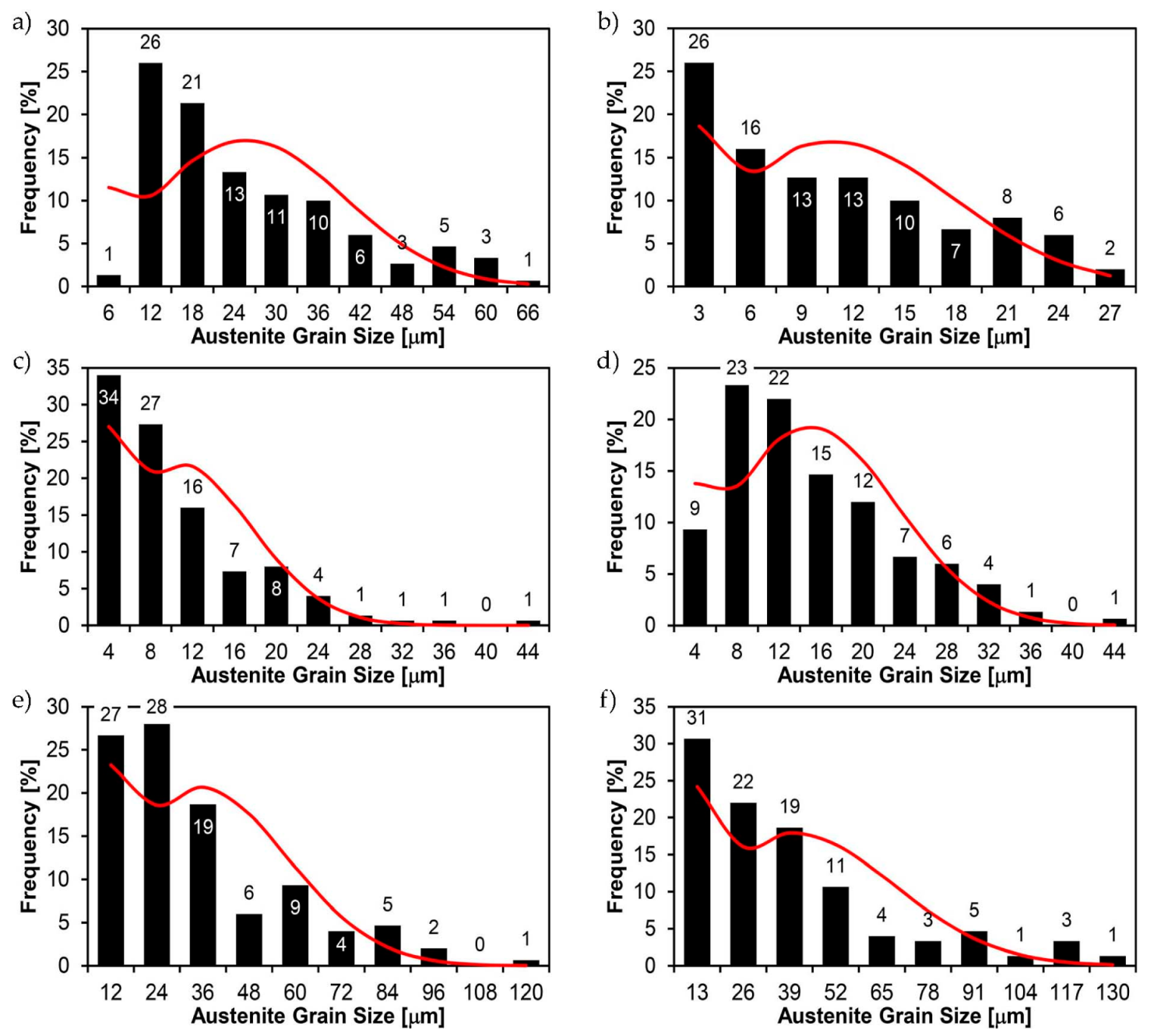

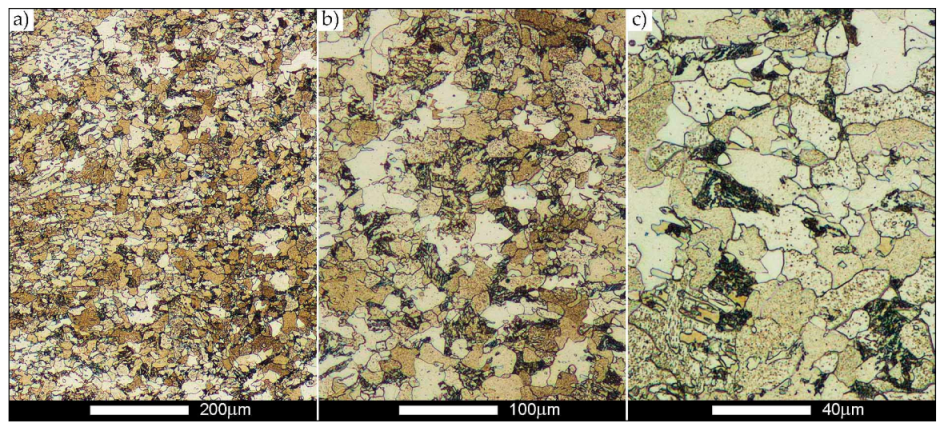

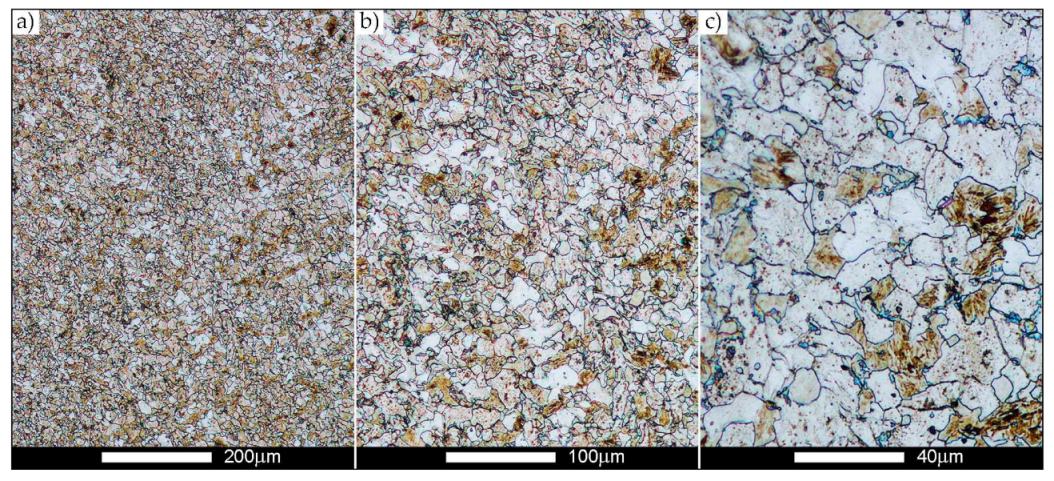
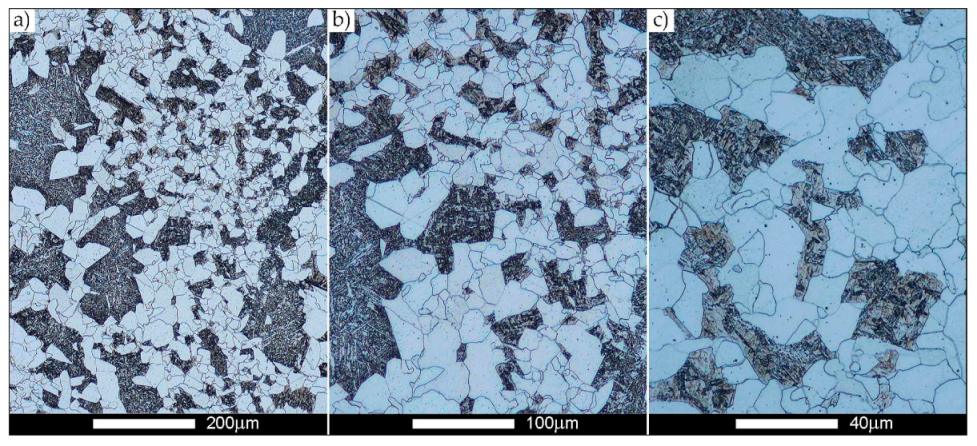
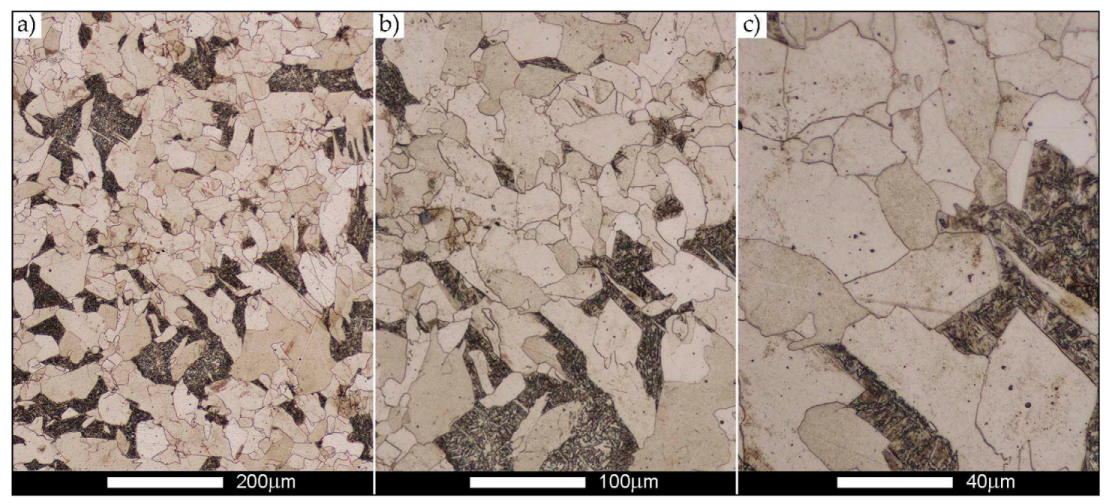
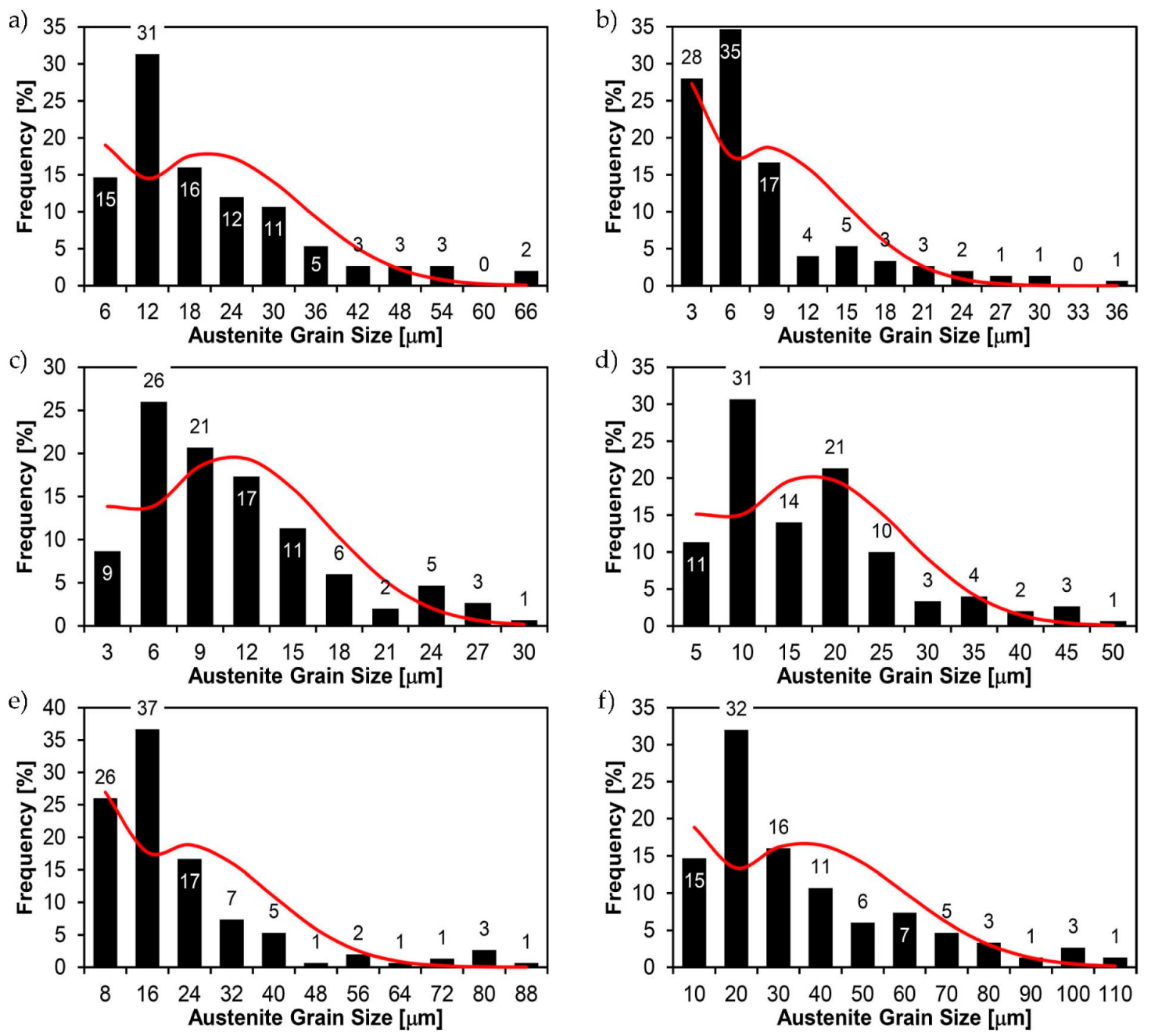
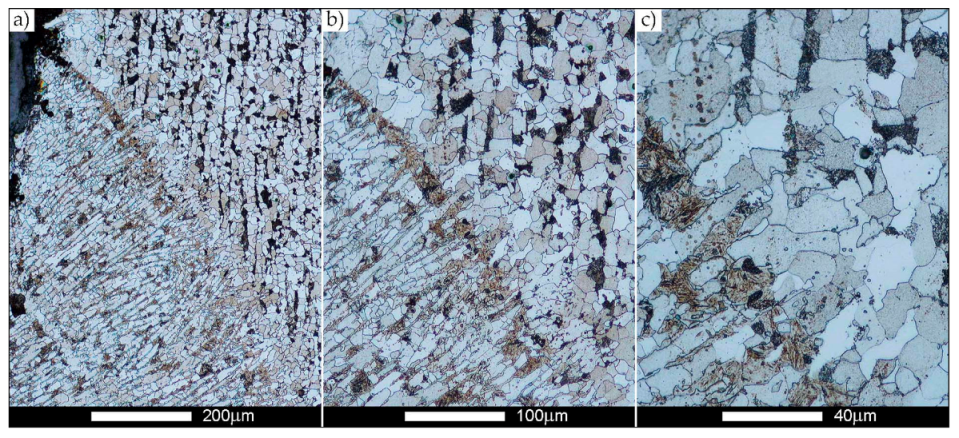
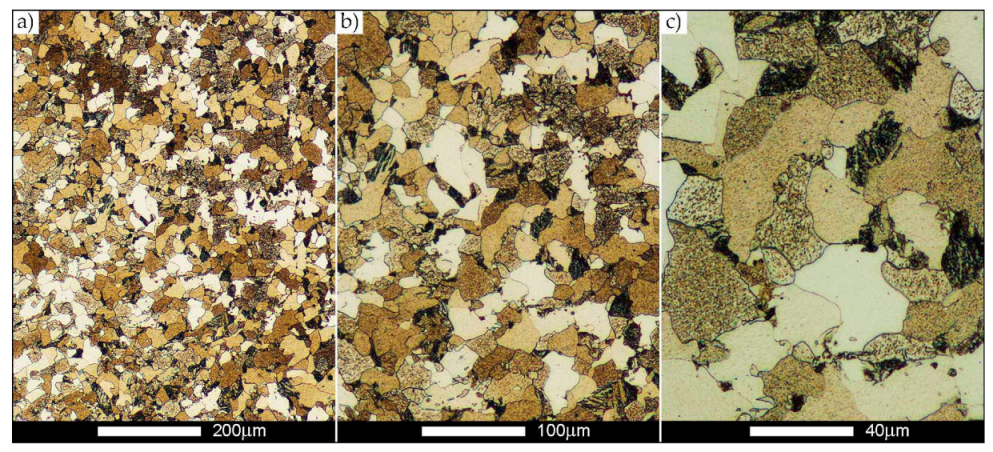
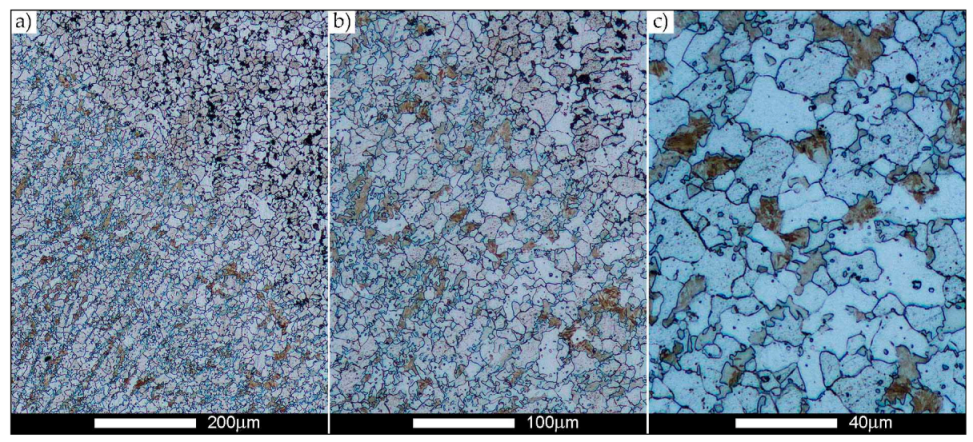
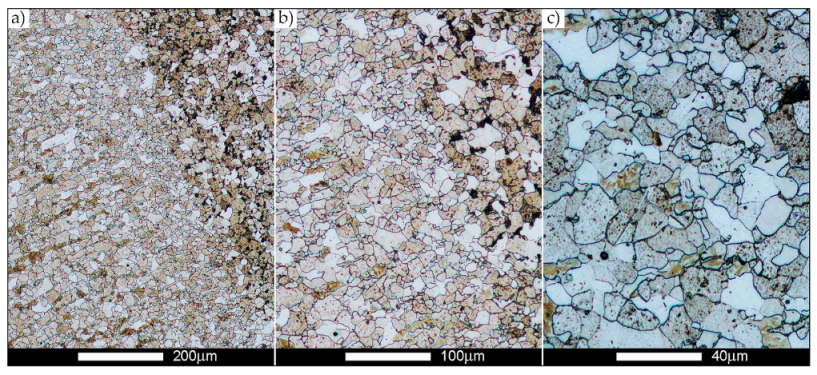


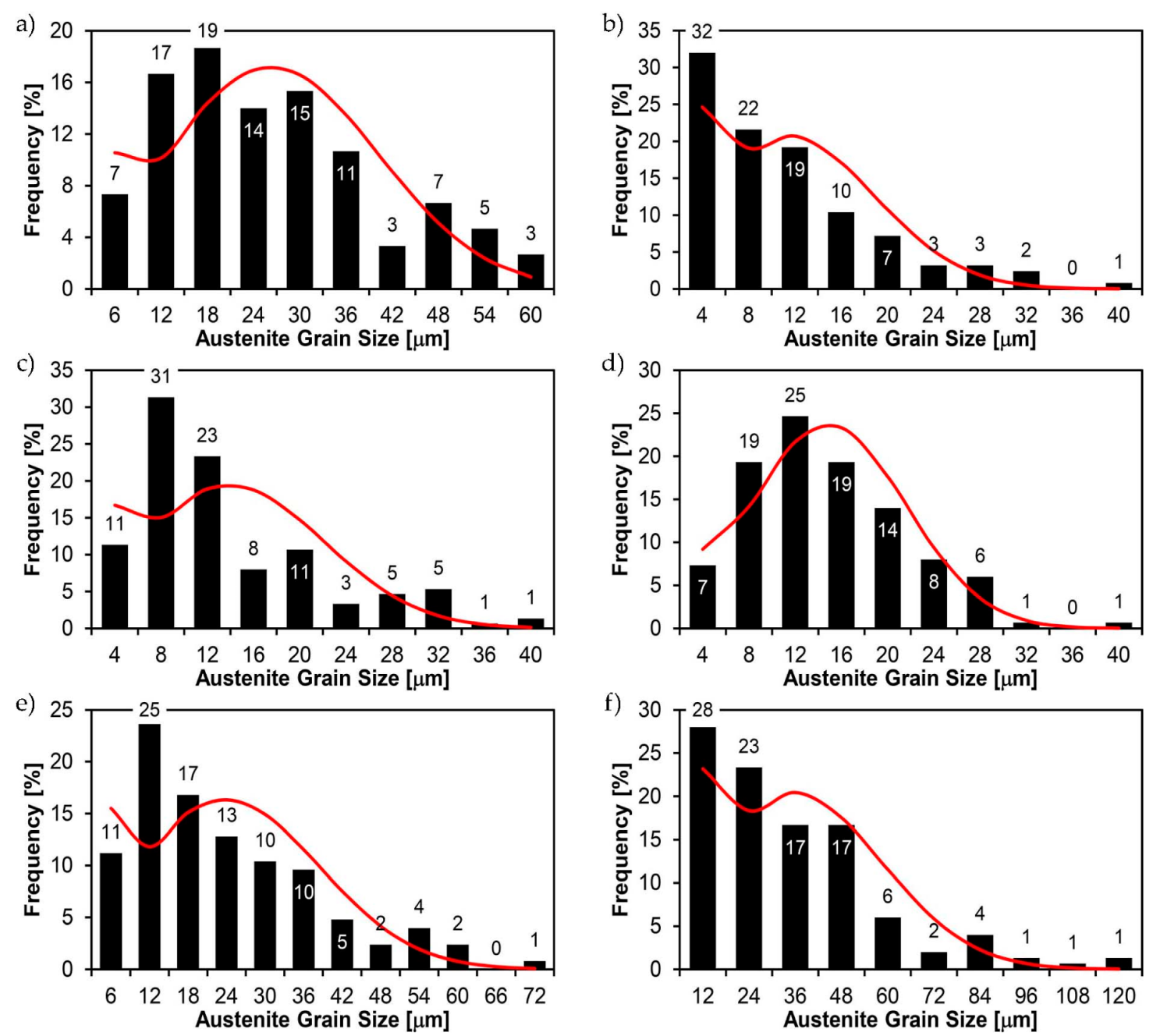
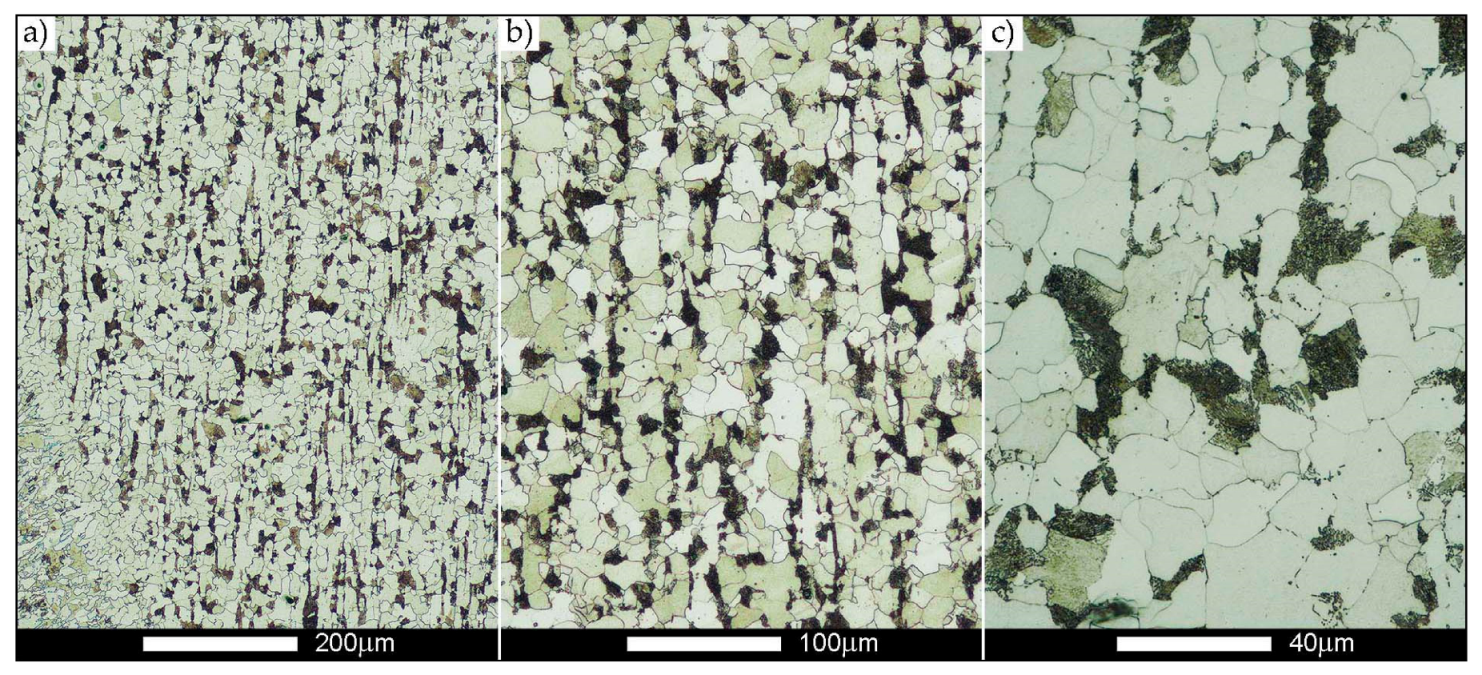

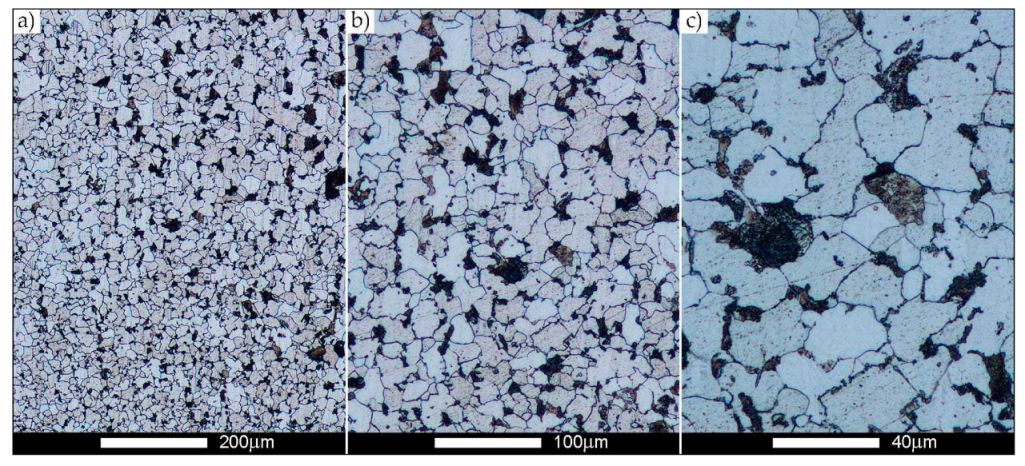
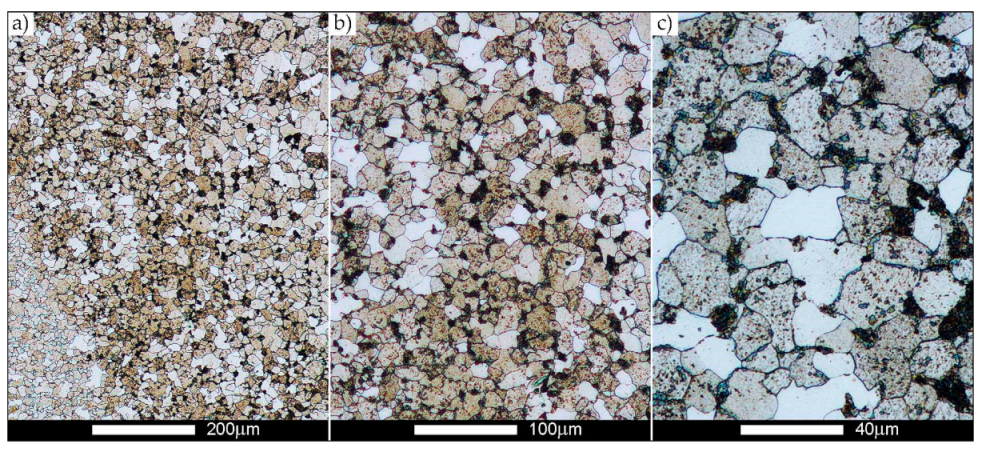
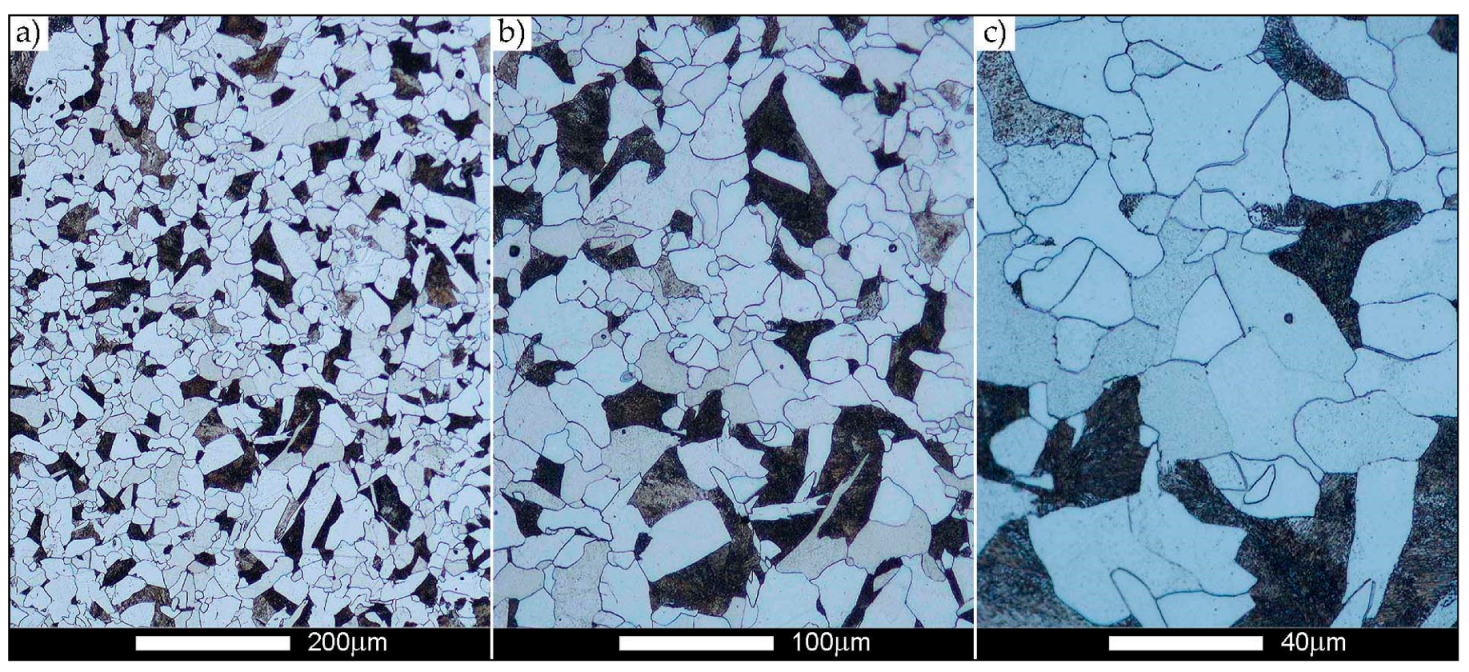
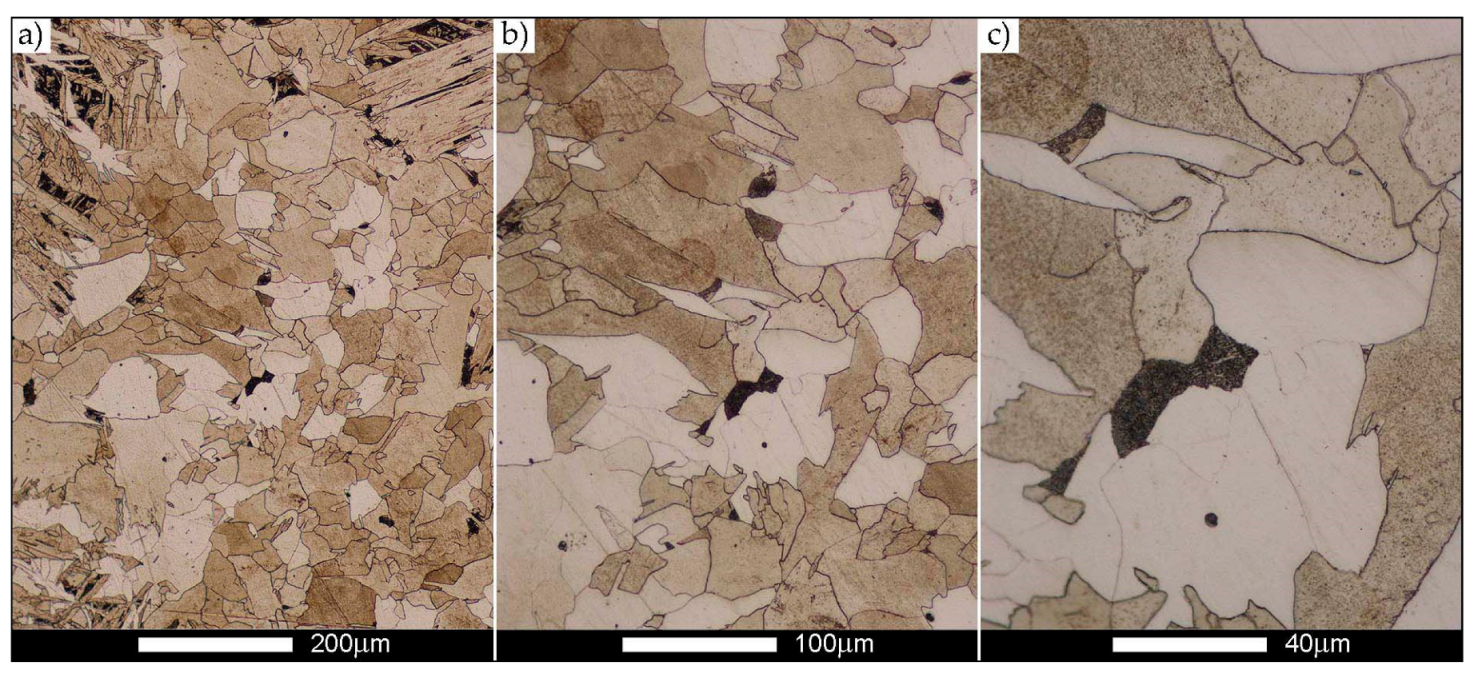

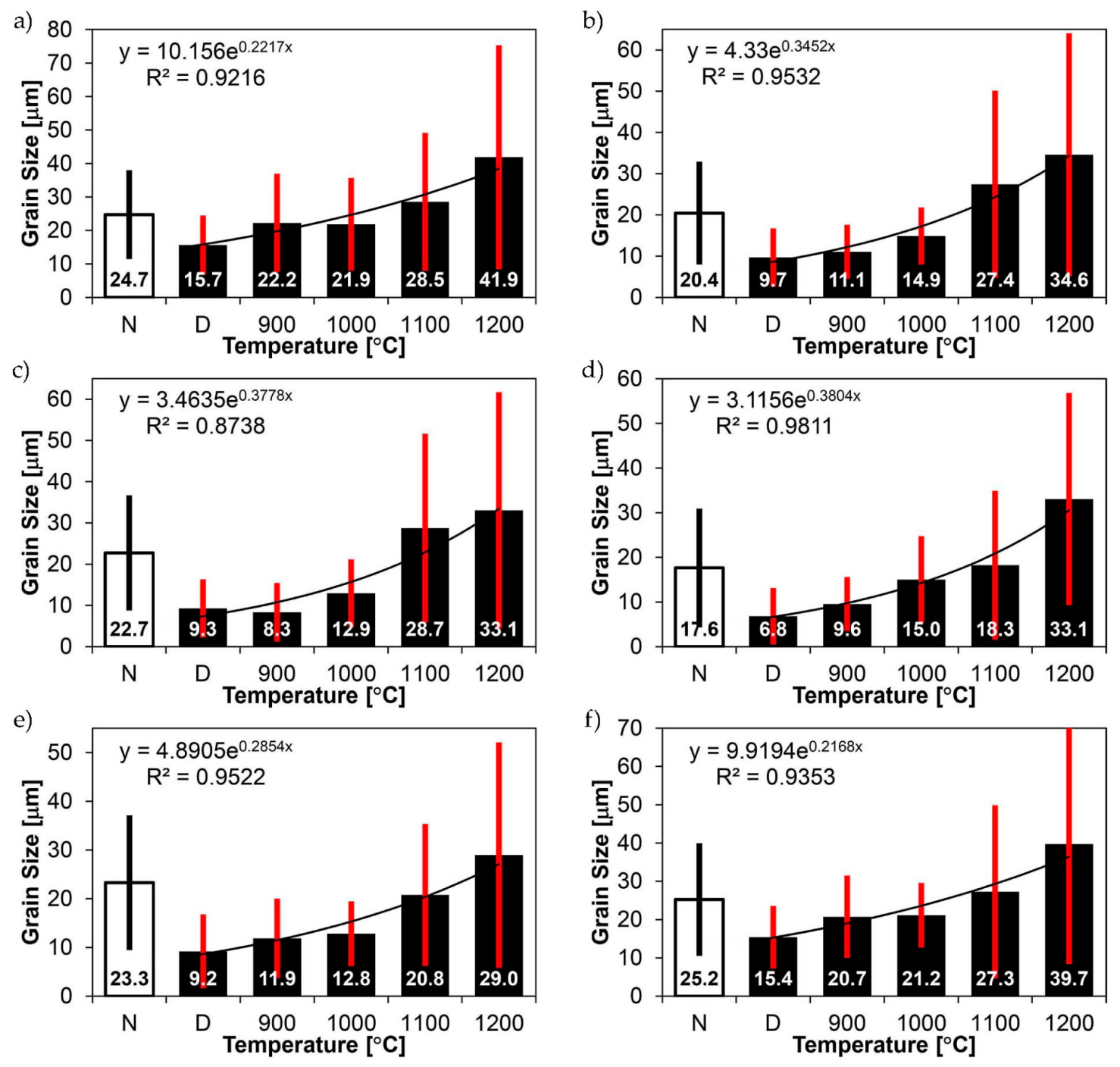

| Sample | C | Mn | Cr | Ni | Mo | V | Cu | CEV | CET | # |
|---|---|---|---|---|---|---|---|---|---|---|
| Selected Element [wt %] | [%] | [mm] | ||||||||
| PD | Max. 0.26 | Max. 1.60 | Max. 1.40 | Max. 1.50 | Max. 0.60 | ND | ND | Max. 0.48 | Max. 0.37 | 3.2–4.9 |
| Max. 0.49 | Max. 0.38 | 5.0–9.9 | ||||||||
| Max. 0.52 | Max. 0.39 | 10.0–19.9 | ||||||||
| Max. 0.60 | Max. 0.41 | 20.0–39.9 | ||||||||
| OR | 0.17 | 1.00 | 0.45 | 0.05 | 0.08 | 0.005 | 0.018 | 0.44 | 0.30 | 10.0 |
| CEV = C + Mn/6 + (Cr + Mo + V)/5 + (Cu + Ni)/15; CET = C + (Mn + Mo)/10 + (Cr + Cu)/20 + Ni/40 | ||||||||||
| Sample | Si | P | S | Al | Ti | Nb | Co | B | # |
|---|---|---|---|---|---|---|---|---|---|
| Selected Element [wt %] | [mm] | ||||||||
| PD | Max. 0.70 | Max. 0.025 | Max. 0.010 | ND | ND | ND | ND | Max. 0.005 | 3.2–4.9 |
| 5.0–9.9 | |||||||||
| 10.0–19.9 | |||||||||
| 20.0–39.9 | |||||||||
| OR | 0.32 | 0.010 | 0.0005 | 0.032 | 0.016 | - | 0.016 | 0.0014 | 10.0 |
| Sample | Rp0.2 | Rm | A | Z | KCV−40 | HBW |
|---|---|---|---|---|---|---|
| [MPa] | [%] | [J/cm2] | ||||
| D (PD) | 1250 | 1400–1600 | 10 | ND | 62.5 | 425–475 |
| D (OR) | 1106 | 1433 | 14.6 | 46.0 | 70.3 | 434 ± 3 |
| Q900 (OR) | 1076 | 1445 | 14.1 | 41.5 | 49.2 | ND |
| Q1000 (OR) | 1016 | 1413 | 13.2 | 37.3 | 38.3 | ND |
| Q1100 (OR) | 1006 | 1425 | 12.9 | 36.5 | 29.7 | ND |
| Q1200 (OR) | 987 | 1382 | 12.6 | 39.0 | 19.0 | ND |
| Weld Deposit | C | Mn | Si | Cr | Ni | Mo | Rp0.2 | Rm | A4 | KCV−40 |
|---|---|---|---|---|---|---|---|---|---|---|
| Chemical Composition [wt.%] | [MPa] | [%] | [J/cm2] | |||||||
| OK Autrod 13.43 + OK Flux 10.62 | 0.11 | 1.50 | 0.25 | 0.60 | 2.20 | 0.50 | 700 | 800 | 21 | 94 |
| No. | Heat Treatment Scheme and Parameters | No. | Heat Treatment Scheme and Parameters | ||
|---|---|---|---|---|---|
| 1 | D | No treatment (as welded) | 2 | N | Normalisation: 900 °C/1 h/Air |
| 3 | N + Q900 | Normalisation: 900 °C/1 h/Air Quenching: 900 °C/1 h/H2O Tempering: 100 °C/2 h/Air | 4 | N + Q1000 | Normalisation: 900 °C/1 h/Air Quenching: 1000 °C/1 h/H2O Tempering: 100 °C/2 h/Air |
| 5 | N + Q1100 | Normalisation: 900 °C/1 h/Air Quenching: 1100 °C/2 h/H2O Tempering: 100 °C/2 h/Air | 6 | N + Q1200 | Normalisation: 900 °C/1 h/Air Quenching: 1200 °C/2 h/H2O Tempering: 100 °C/2 h/Air |
| 7 | D + A | Austenitisation: 850 °C/10 min. Isothermal cooling: 850–650 °C/5 min/Air | 8 | N + A | Normalisation: 900 °C/1 h/Air Austenitisation: 900 °C/10 min Isothermal cooling: 900–650 °C/5 min/Air |
| 9 | N + A900 | Normalisation: 900 °C/1 h/Air Austenitisation: 900 °C/1 h Isothermal cooling: 900–650 °C/5 min/Air | 10 | N + A1000 | Normalisation: 900 °C/1 h/Air Austenitisation: 1000 °C/1 h Isothermal cooling: 1000–650 °C/5 min/Air |
| 11 | N + A1100 | Normalisation: 900 °C/1 h/Air Austenitisation: 1100 °C/2 h Isothermal cooling: 1100–650 °C/10 min/Air | 12 | N + A1200 | Normalisation: 900 °C/1 h/Air Austenitisation: 1200 °C/2 h Isothermal cooling: 1200–650 °C/10 min/Air |
Publisher’s Note: MDPI stays neutral with regard to jurisdictional claims in published maps and institutional affiliations. |
© 2021 by the authors. Licensee MDPI, Basel, Switzerland. This article is an open access article distributed under the terms and conditions of the Creative Commons Attribution (CC BY) license (https://creativecommons.org/licenses/by/4.0/).
Share and Cite
Konat, Ł.; Zemlik, M.; Jasiński, R.; Grygier, D. Austenite Grain Growth Analysis in a Welded Joint of High-Strength Martensitic Abrasion-Resistant Steel Hardox 450. Materials 2021, 14, 2850. https://doi.org/10.3390/ma14112850
Konat Ł, Zemlik M, Jasiński R, Grygier D. Austenite Grain Growth Analysis in a Welded Joint of High-Strength Martensitic Abrasion-Resistant Steel Hardox 450. Materials. 2021; 14(11):2850. https://doi.org/10.3390/ma14112850
Chicago/Turabian StyleKonat, Łukasz, Martyna Zemlik, Robert Jasiński, and Dominika Grygier. 2021. "Austenite Grain Growth Analysis in a Welded Joint of High-Strength Martensitic Abrasion-Resistant Steel Hardox 450" Materials 14, no. 11: 2850. https://doi.org/10.3390/ma14112850
APA StyleKonat, Ł., Zemlik, M., Jasiński, R., & Grygier, D. (2021). Austenite Grain Growth Analysis in a Welded Joint of High-Strength Martensitic Abrasion-Resistant Steel Hardox 450. Materials, 14(11), 2850. https://doi.org/10.3390/ma14112850






